| 1 |
|
|
Printed Book |
Evidence of ICTs Integration in Agricultural Extension Services |
Bidyapati Thangjam, Kaushal Kumar Jha, Nongmaithem Raju Singh, Deepa Thangjam. Rocky Thokchom |
410 |
978-81-980121-9-7 |
Background
The world population is expected to reach 9.6 billion by 2050, which will significantly increase food demand. In this context, challenges such as climate change, rising population, food security and land degradation are recognized as major threats to global agricultural systems. Information and Communication Technology (ICT) plays a crucial role in addressing the information gaps faced by farmers. ICT has the potential to reach even the most disadvantaged farmers, helping mitigate the vulnerabilities and risks associated with agriculture. The integration of ICT tools in agricultural extension services enhances the delivery of relevant and accurate information tailored to the needs of farmers. ICT tools used in extension services range from radios and satellite imagery to mobile phones and electronic money transfers. ICT-based extensions promote learning, facilitate the adoption of new technologies and provide early information about weather patterns and crop yields by collecting data through remote sensors. ICTs in agricultural extension involve both one-way and two-way communication between farmers and agricultural experts. Many ICT-based extension services, such as social media platforms, mobile phones and web portals, can be accessed through internet connections. These services often provide information in the form of SMS, images and phone calls, which have been shown to significantly impact farm productivity. The power of ICT tools in agriculture is unlocked through extension services, which have led to important changes in the agricultural sector. These services enable farmers to achieve higher yields, optimize crop management and reduce input costs. To fully harness the potential of ICT in agriculture, proper guidelines should be developed for extension agencies to engage farmers through more effective and widespread digital interactions. This will help achieve the goal of creating an e-agriculture nation.
Contents of the book
ICTs and its Tool In Agricultural Extension Services
What is ICT?
The need for ICTs in agricultural extension services
ICT tools for agricultural extension services
Role of ICTs in Agricultural Extension: Transforming Agriculture
Role of ICT in agricultural extension
Efficient problem diagnosis in farming practices
Improve access to market information services
Efficient and accessible agricultural financial services
Capacity development and skill training
Enhancing data collection and feedback mechanisms
Promote in rural sectors and create awareness
Enhancing risk mitigation services for farmers
Traditional Mass Media-Based ICT Services For Agricultural Extension
Key components of mass media-based ICT in agricultural extension
Radio
Popular community radio in agriculture services
Advantage of using radio in agriculture services
Television
Popular Television channel engaged with agricultural services
Advantages of TV in agricultural extension services
Social Media For Agricultural Extension Services
Key features and benefits of social media in agricultural extension services
Types social media platform used in information sharing and communication
How to integrate social media in extension service
Challenges of using social media for agricultural extension services
Popular Social Media Platform Transforming Extension Services
Facebook
YouTube
WhatsApp
Twitter
Telegram
Blog
Role of Mobile Technology In Modern Agricultural Extension
Most frequently utilized mobile applications for agricultural
A Success stories of mobile application in agriculture advisory services
Web Portal-Web-Based ICT Applications In Extension Services
List of web portal as an information sharing platform for technology transfer
Evident of successful utilization of web based expert system
Expert System For Agriculture And Extension Services
What is Expert system?
Importance of Expert Systems in Agriculture
Role of Expert Systems in Agriculture
List of agricultural expert system for crop advisory service
Advantages of using experts systems in agriculture
Smart Agriculture Through Modern Extension Services
Remote Sensing
Application of remote sensing in agriculture
Challenges in remote sensing for agriculture
Drones
Evidence of drone use in agriculture
Challenges of using drones in agriculture
Internet of Things (IoT) Promote Sustainable Practices
Key Components of IoT in agriculture
Applications of IoT in agriculture
Precision farming and resource management
Data management and decision support system
Community Engagement and Knowledge Sharing
Building resilience through community engagement
Sustainable supply chains and market access
|
Bidyapati Thangjam
Kaushal Kumar Jha
Nongmaithem Raju Singh
Deepa Thangjam
Rocky Thokchom
|
|
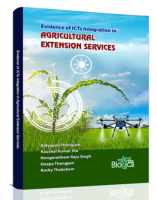 |
2025-04-08 17:46:24 |
Edit |
Delete |
| 2 |
|
|
Printed Book |
Essential Laboratory Techniques of Plant Biotechnology, Biochemistry and Physiology |
Debanjana Saha, Udit Nandan Mishra, Ankita Mohanty, Rajesh Kumar Singhal |
380 |
978-81-980121-5-9 |
Background
The Laboratory Manual of Essential Techniques in Plant Biotechnology, Biochemistry, and Physiology is a comprehensive, hands-on guide designed for students, educators, and researchers in plant science. It bridges theoretical concepts with practical skills, offering detailed protocols, clear objectives, and step-by-step instructions for a wide range of laboratory techniques. The manual covers core areas such as DNA extraction, PCR, enzymatic assays, metabolic profiling, and physiological experiments related to photosynthesis, transpiration, and stress responses. By integrating plant biotechnology with biochemical and physiological approaches, it highlights applications in crop improvement, stress adaptation, and sustainable agriculture. This manual not only supports learning but also fosters critical thinking, data analysis, and experimental design, making it a vital resource for experiential learning and scientific growth in the plant sciences.
Contents of the book
SECTION-A
- Laboratory setup and requirements for plant tissue culture
- Sterilization procedure for plant tissue culture
- Preparation of MS nutrient media
- Direct and indirect organogenesis of plant tissue culture
- Embryo culture
- Anther culture
- Somatic embryogenesis
- Cell suspension
- Isolation of plant genomic DNA by CTAB method
- RNA isolation by TRIzol reagent
- PCR analysis
- Agarose gel electrophoresis
- Gene cloning
- Gene transformation in plant leaf discs mediated by agrobacterium
- Gene transformation in plants mediated by particle bombardment
- Southern blotting
- Northern blotting
- Western blotting
- RT-PCR analysis
- cDNA library preparation
SECTION-B
- Quantitative estimation of titratable acidity using titration
- Preparation of buffer solutions of varying pH
- Estimation of total soluble sugars (total carbohydrates)
- Estimation of reducing sugars
- Estimation of starch by anthrone reagent
- Estimation of nitrogen by Micro-Kjeldahl Method
- Estimation of protein by Biuret Method
- Estimation of protein by Lowry's Method
- Estimation of protein by Uv-Absorption (A280) Method
- Separation of plant pigment through paper chromatography
- Action of salivary amylase on storage polysaccharide under varying pH and temperature range
- Polyacrylamide-Sodium Dodecyl Sulphate Gel Electrophoresis (SDS-PAGE) of proteins
- Extraction of total lipids
- Estimation of oil or crude fat content in oilseeds
- Isolation and estimation of free fatty acids
- Determination of free fatty acids or acid value of an oil
- Determination of iodine value of an oil
- Determination of saponification value of fat/oil
- Extraction of enzymes
- Assay of amylase enzymes
- Assay of lipase enzyme
- Estimation of chlorophyll
- Estimation of oxalic acid
- Antioxidant enzyme assay
|
Debanjana Saha
Udit Nandan Mishra
Ankita Mohanty
Rajesh Kumar Singhal
|
|
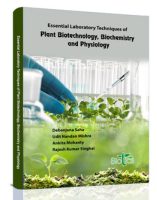 |
2025-04-08 17:38:35 |
Edit |
Delete |
| 3 |
|
|
Upcoming Book |
ID 18 Integrated Farming Systems: A Holistic Approach to Sustainable Agriculture |
Open Access Book |
00.00 |
Coming soon |
Background
This book is written to address the growing need for sustainable and efficient farming practices in the face of climate change, resource depletion and food security challenges. Integrated Farming Systems (IFS) provide a holistic approach by combining crops, livestock, aquaculture, agroforestry and waste recycling to maximize productivity while maintaining environmental balance. The book covers key topics such as the fundamentals of IFS, ecological and economic benefits, system design and implementation, modern technological interventions (AI, IoT and precision farming) and real-world case studies. It also explores sustainable soil management, organic inputs, pest control and climate-resilient farming techniques. This book is designed for a diverse audience, including farmers seeking to optimize their yields sustainably, researchers exploring innovative agricultural models, policymakers shaping future farming strategies and students studying modern agricultural science. The book serves as a comprehensive guide to transforming agriculture into a more productive, resilient and eco-friendly system.
Tentative Titles/Themes of Chapter (New chapter titles may be proposed)
Introduction
- Unveiling the Green Matrix: Foundations and Future of Integrated Farming Systems
- Tracing Roots: Historical Perspectives and Evolution of Integrated Farming Practices
Sustainable Farming Practices
- Building Sustainable Farms: Core Principles and Practices for Long-Term Success
- Agroecology: Harmonizing Ecology and Agriculture for Resilient Farming Systems
- Organic Farming: Integrating Organic Principles into Holistic Farming Systems
- Permaculture: Designing Integrated Farming Landscapes for Sustainable Living
Crop Production
- Diverse Crop Landscapes: Strategies for Effective Crop Diversification
- Intercropping Innovations: Maximizing Yield and Resilience through Mixed Cropping Systems
- Rejuvenating Soil Health: Crop Rotation Techniques for Pest and Nutrient Management
- Green Manures and Cover Crops: Enhancing Soil Fertility and Ecosystem Services
Precision Farming
- Precision Agriculture: Revolutionizing Farming with Advanced Technologies
- Smart Soil Health: Monitoring and Management for Optimal Crop Production
- Precision Irrigation: Advanced Water Management Techniques for Sustainable Farming
- Targeted Pest and Disease Management: Precision Tools and Strategies
- Data-Driven Farming: Harnessing Yield Monitoring and Analytics for Better Decisions
Livestock Integration
- Synergy in Farming: Integrating Livestock for Enhanced Farm Productivity
- Sustainable Dairy Practices: Integrating Cattle into Holistic Farming Systems
- Piggery Innovations: Combining Swine Farming with Crop Production for Mutual Benefits
- Integrated Poultry Farming: Balancing Crop and Poultry Production for Sustainable Gains
- Duckery and Aquatic Systems: Integrating Ducks for Pest Control and Nutrient Cycling
Aquaculture and Fisheries
- Integrated Fish Farming: Techniques for Harmonizing Aquaculture with Agriculture
- Paddy-Cum-Fish Culture: Sustainable Practices for Rice and Fish Co-Production
- Aquaponics: Synergizing Fish and Plant Farming for Efficient Resource Use
- Ensuring Quality: Water Management Techniques for Sustainable Aquaculture
Beekeeping and Pollination
- Beekeeping in Integrated Systems: Enhancing Pollination and Biodiversity
- Pollinator Partnerships: Strategies for Boosting Crop Yields through Beekeeping
- Honey Harvest: Integrating Honey Production with Sustainable Farm Practices
Sericulture and Silk Production
- Silk Road: Integrating Sericulture into Modern Farming Systems
- Mulberry Cultivation: Best Practices for Supporting Sericulture
- Protecting the Silk: Disease Management and Biosecurity in Sericulture
Agroforestry and Tree Integration
- Agroforestry Landscapes: Designing Farms with Trees for Multiple Benefits
- Multipurpose Trees: Species Selection for Integrated Farming Systems
- Alley Cropping and Silvopasture: Combining Trees and Crops for Sustainable Productivity
Soil and Water Conservation
- Guardians of the Soil: Conservation Techniques for Sustainable Farming
- Ridge and Furrow Systems: Effective Water Management for Enhanced Crop Growth
- Rainwater Harvesting: Sustainable Practices for Water Resource Management
Nutrient Management
- Integrated Nutrient Management: Balancing Organic and Inorganic Inputs
- Composting and Vermiculture: Transforming Waste into Nutrient-Rich Resources
- Biofertilizers: Harnessing Microbial Solutions for Soil Fertility and Crop Growth
Pest and Disease Management
- Integrated Pest Management: Holistic Approaches to Pest Control
- Biological Warriors: Utilizing Natural Enemies for Pest Management
- Disease Defense: Integrated Strategies for Crop and Livestock Health
Socio-Economic and Policy Aspects
- Economics of Integration: Financial Benefits and Viability of Integrated Farming
- Policy and Support: Creating an Enabling Environment for Integrated Farming Systems
- Empowering Farmers: Training and Capacity Building for Sustainable Practices
Case Studies and Innovations
- Stories of Success: Case Studies of Thriving Integrated Farming Systems
- Innovative Frontiers: Cutting-Edge Technologies and Practices in Integrated Farming
Climate Resilience
- Climate-Smart Farming: Adaptation Strategies for Integrated Farming Systems
- Building Resilience: Enhancing Farm Stability through Integrated Approaches
Conclusion
- Charting the Future: The Path Ahead for Integrated Farming Systems
**Chapter title may be modified or new chapter may also be proposed by the author.
CHAPTER SUBMISSION PROCEDURE:
Book Chapter may be submitted through e-mail: [email protected]
FOR ANY QUERIES:
Contact:+91-9863023086
Mail us: [email protected]
Authors' Guidelines Publication Package
|
|
IMPORTANT DATES:
- Chapter booking ends: 25th April, 2025
- Chapter submission ends: 25th May, 2025
CHAPTER SUBMISSION PROCEDURE:
Book Chapter may be submitted through e-mail: [email protected]
FOR ANY QUERIES:
Contact:+91-9863023086
Mail us: [email protected]
Authors' Guidelines Publication Package
|
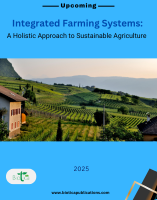 |
2025-03-29 12:08:57 |
Edit |
Delete |
| 4 |
|
|
Upcoming Book |
ID 25 Sustainable Rice Production: Research Perspectives on Water, Soil and Climate Resilience |
Open Access Book |
Coming soon |
Coming soon |
Background
This is a comprehensive book exploring the latest research and innovations in sustainable rice farming. With increasing environmental challenges, this book highlights strategies to enhance soil health, optimize water use, and develop climate-resilient rice varieties. Covering topics such as precision agriculture, integrated nutrient management, organic and biofertilizer applications, and cutting-edge genetic research, this book provides practical and research-backed solutions for sustainable rice cultivation. It delves into key aspects like pest and disease management, mechanization, artificial intelligence in agriculture, and eco-friendly irrigation techniques like alternate wetting and drying (AWD). The book also examines the socio-economic dimensions of sustainable rice farming, including government policies, farmer cooperatives, and market-driven sustainability initiatives. It features case studies from successful rice-growing regions, blending traditional wisdom with modern scientific advancements. Designed for researchers, agronomists, policymakers, and progressive farmers, this book serves as a valuable resource to address the challenges of global rice production in an era of climate change.
Tentative Titles/Themes of Chapter (New chapter titles may be proposed)
-
The Future of Rice: Balancing Productivity and Sustainability
-
Decoding Soil Health: The Foundation of Resilient Rice Farming
-
Secrets Beneath the Surface: Managing Soil Fertility for Maximum Yield
-
Biofertilizers and Microbial Magic: The New Age of Soil Enrichment
-
From Depletion to Restoration: Reviving Soil in Continuous Rice Cultivation
-
Water Wisdom: Unlocking Efficient Irrigation in Rice Fields
-
Rice Without Floods: The AWD Method and Water Conservation Breakthroughs
-
Smart Watering: Precision Irrigation for Climate-Smart Rice Farming
-
Drought-Proofing Rice: The Rise of Water-Efficient Varieties
-
Groundwater Matters: Strategies for Sustainable Water Management
-
Climate Chaos and Rice: Adapting to a Changing World
-
Super Rice for a Warming Planet: Breeding Climate-Resilient Varieties
-
The Carbon Footprint of Rice: Can We Grow It Green?
-
Tackling Extreme Weather: Resilience Strategies for Rice Farmers
-
Harnessing Big Data: Weather Forecasting for Smart Rice Farming
-
Feeding the Soil, Not Just the Crop: The Power of Integrated Nutrients
-
Nano-Fertilizers and Smart Nutrition: The Future of Rice Productivity
-
Organic Boost: How Bio-Based Fertilizers Are Changing the Game
-
Customizing Nutrients: Precision Nutrition for Maximum Yield
-
Healing the Soil: The Role of Amendments in Long-Term Sustainability
-
The War Against Pests: Revolutionizing Rice Protection with IPM
-
Beneficial Bugs and Biocontrol: Nature’s Answer to Rice Pests
-
The Hidden Threat: Combating Emerging Rice Diseases
-
Smart Weed Control: Strategies Beyond Herbicides
-
Gene Silencing for Pest Control: The RNA Revolution in Rice Farming
-
Ancient Grains, Future Crops: Preserving Indigenous Rice Varieties
-
The Hybrid Revolution: Can It Make Rice Farming More Sustainable?
-
CRISPR and Gene Editing: Designing the Rice of Tomorrow
-
Farmers as Scientists: The Power of Participatory Breeding
-
Seeds of Change: Ensuring Quality and Resilient Rice Seeds
-
Drones Over Paddies: The Role of Aerial Technology in Rice Farming
-
Precision Farming for Rice: Data-Driven Decisions for Better Yields
-
Harvesting Innovation: The Rise of Mechanized Rice Farming
-
AI in Agriculture: How Smart Machines Are Transforming Rice Production
-
Robotics and Automation: The Future of Rice Farm Management
-
The Business of Sustainability: Can Green Rice Be Profitable?
-
Policies That Work: How Governments Can Promote Sustainable Rice
-
Farmer Power: The Role of Cooperatives in Rice Sustainability
-
Women in Rice Farming: Driving Change from the Fields
-
Exporting Sustainability: The Global Market for Climate-Friendly Rice
-
Learning from the Best: Success Stories in Sustainable Rice Cultivation
-
Traditional Wisdom, Modern Science: A Winning Combination for Rice Farming
-
From Local to Global: Scaling Up Sustainable Rice Production
-
The Role of Public-Private Partnerships in Driving Sustainability
-
Future-Proofing Rice: Innovations on the Horizon
-
The Role of Biotechnology in Sustainable Rice Farming
-
Harnessing Artificial Intelligence for Climate-Resilient Rice Cultivation
-
Sustainable Rice Supply Chains: From Farm to Fork
-
Empowering Farmers with Knowledge: Training and Extension for Sustainability
-
The Road Ahead: Transforming Rice Farming for a Sustainable Future
CHAPTER SUBMISSION PROCEDURE:
Book Chapter may be submitted through e-mail: [email protected]
FOR ANY QUERIES:
Contact:+91-9863023086
Mail us: [email protected]
Authors' Guidelines Publication Package
|
|
IMPORTANT DATES:
- Chapter booking ends: 25th April, 2025
- Chapter submission ends: 25th May, 2025
CHAPTER SUBMISSION PROCEDURE:
Book Chapter may be submitted through e-mail: [email protected]
FOR ANY QUERIES:
Contact:+91-9863023086
Mail us: [email protected]
Authors' Guidelines Publication Package
|
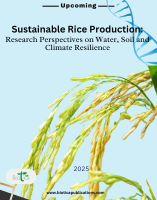 |
2025-03-26 07:35:40 |
Edit |
Delete |
| 5 |
|
|
Upcoming Book |
ID 24 Nanotechnology for Sustainable Agriculture: Opportunities and Challenges |
Open Access Book |
Coming soon |
Coming soon |
Background
The book explores the transformative role of nanotechnology in addressing key agricultural challenges while promoting sustainability. It delves into the latest research on nano-enabled fertilizers, pesticides, and smart delivery systems that enhance nutrient efficiency, improve soil health, and reduce environmental contamination. The book also examines the application of nanomaterials in precision farming, water conservation, disease detection, and post-harvest management. By integrating nanotechnology with sustainable agricultural practices, it aims to improve crop productivity and resilience in the face of climate change and resource constraints. A key focus is on the safety and regulatory aspects of nanotechnology, addressing concerns regarding toxicity, environmental risks, and public perception. The objective is to bridge the gap between advanced research and real-world agricultural applications by presenting innovative solutions that align with global food security and environmental goals. The book highlights the potential of nanotechnology to minimize chemical inputs, reduce post-harvest losses, and improve water-use efficiency, making agriculture more resource-efficient and eco-friendly. As global food demand continues to rise, nanotechnology offers new possibilities for enhancing agricultural productivity while ensuring sustainability. This book serves as a valuable resource for researchers, policymakers, agripreneurs, students and practitioners working towards a future of smarter and more resilient agriculture.
Tentative Titles/Themes of Chapter (New chapter titles may be proposed)
Theme 1: Fundamentals and Principles of Nanotechnology in Agriculture
-
Introduction to Nanotechnology in Agriculture: Concepts and Scope
-
Nanomaterials for Precision Farming: Types and Applications
-
Smart Nanoparticles for Sustainable Agricultural Inputs
-
Nano-Bio Interactions: Implications for Plant Growth and Soil Health
-
Green Synthesis of Nanomaterials for Agricultural Applications
Theme 2: Nano-Fertilizers and Soil Health Management
-
Nano-Fertilizers: A Sustainable Alternative to Conventional Fertilizers
-
Role of Nanotechnology in Enhancing Soil Nutrient Retention
-
Bioavailability and Uptake Mechanisms of Nano-Fertilizers in Plants
-
Nano-Biochar for Soil Remediation and Carbon Sequestration
-
Microbial Interactions with Nanoparticles: Effects on Soil Microbiota and Fertility
Theme 3: Nanotechnology for Crop Protection and Pest Management
-
Nano-Pesticides: Eco-Friendly Solutions for Pest and Disease Control
-
Nano-Encapsulation of Biopesticides: Enhancing Efficacy and Stability
-
Nanotechnology-Based Early Detection of Plant Diseases
-
Nanostructured Insect Traps and Their Role in Sustainable Pest Management
-
Toxicity and Risk Assessment of Nano-Agrochemicals on Non-Target Organisms
Theme 4: Nanotechnology in Water and Environmental Sustainability
-
Nano-Based Water Purification Systems for Agricultural Use
-
Nano-Remediation of Heavy Metal Contaminants in Agricultural Lands
-
Nanotechnology for Efficient Irrigation and Water Conservation
-
Sensing and Removal of Pesticide Residues Using Nanomaterials
-
Climate-Smart Agriculture: Role of Nanotechnology in Carbon Footprint Reduction
Theme 5: Nanotechnology in Seed Science and Post-Harvest Management
-
Nano-Coatings for Seed Priming and Germination Enhancement
-
Post-Harvest Preservation and Shelf-Life Extension Using Nanomaterials
-
Nano-Sensors for Monitoring Crop Maturity and Food Quality
-
Nano-Packaging: Smart Solutions for Sustainable Food Storage
-
Nanotechnology-Based Alternatives for Reducing Post-Harvest Losses
Theme 6: Safety, Policy, and Future Prospects of Nano-Agriculture
-
Nanotoxicology: Safety Considerations for Nano-Enabled Agricultural Products
-
Regulatory Frameworks for Nanotechnology in Agriculture
-
Ethical and Social Implications of Nanotechnology Adoption in Farming
-
Public Perception and Acceptance of Nanotechnology in Agriculture
-
Future Prospects and Challenges of Nanotechnology in Sustainable Farming
CHAPTER SUBMISSION PROCEDURE:
Book Chapter may be submitted through e-mail: [email protected]
FOR ANY QUERIES:
Contact:+91-9863023086
Mail us: [email protected]
Authors' Guidelines Publication Package
|
|
IMPORTANT DATES:
- Chapter booking ends: 25th April, 2025
- Chapter submission ends: 25th May, 2025
CHAPTER SUBMISSION PROCEDURE:
Book Chapter may be submitted through e-mail: [email protected]
FOR ANY QUERIES:
Contact:+91-9863023086
Mail us: [email protected]
Authors' Guidelines Publication Package
|
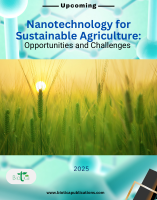 |
2025-03-26 07:27:17 |
Edit |
Delete |
| 6 |
|
|
Upcoming Book |
ID 27 Sustainable Livelihoods: Integrating agriculture with allied sectors for holistic rural development |
Open Access Book |
Coming soon |
Coming soon |
Background
The book emphasizes the need for an integrated approach, combining crop cultivation with livestock, fisheries, agroforestry, and value-added enterprises to enhance farmers' income and resilience. It discusses sustainable agricultural practices, climate-smart solutions, and modern technologies, ensuring environmental conservation while boosting productivity. Case studies highlight successful models of rural development, entrepreneurship, and cooperative frameworks that empower communities. The book also addresses policy interventions, financial support mechanisms, and capacity-building strategies to strengthen rural economies. It advocates for a participatory approach involving farmers, researchers, policymakers, and stakeholders to create self-sustaining, climate-resilient rural livelihoods. This comprehensive resource is ideal for policymakers, academicians, development practitioners, and students working toward holistic rural transformation through an integrated agricultural approach.
Tentative Titles/Themes of Chapter (New chapter titles may be proposed)
Theme 1: Foundations of Sustainable Livelihoods
-
Rethinking Rural Development: The Need for an Integrated Approach
-
The Future of Farming: Sustainability Beyond Crop Cultivation
-
Bridging the Gap: Agriculture, Livelihoods, and Economic Growth
-
Climate Resilience in Rural Livelihoods: Strategies for the Future
-
Sustainable Agriculture: A Blueprint for Prosperity
Theme 2: Crop Cultivation and Diversification
-
Beyond Monoculture: Diversified Farming for Resilient Livelihoods
-
Climate-Smart Agriculture: Innovations for a Changing World
-
Precision Farming: Harnessing Technology for Higher Yields
-
Organic and Natural Farming: The Road to Healthier Soils
-
Seed to Success: Enhancing Productivity Through Improved Varieties
Theme 3: Integrating Livestock for Economic Stability
-
Livestock Revolution: Enhancing Farm Incomes through Animal Husbandry
-
Dairy Development: The White Gold of Rural Prosperity
-
Poultry and Goatery: Small Livestock, Big Impact
-
Sustainable Feed and Fodder Management for Livestock Growth
-
Animal Health and Disease Management: Ensuring Productivity
Theme 4: Fisheries and Aquaculture for Livelihood Enhancement
-
Blue Revolution: Unlocking the Potential of Fisheries in Rural Economies
-
Integrated Fish Farming: A Model for Sustainable Livelihoods
-
Freshwater Aquaculture: Opportunities and Challenges
-
Cage and Recirculatory Aquaculture Systems: The Future of Fish Farming
-
Ornamental Fisheries and Pearl Farming: Profitable Alternatives
Theme 5: Agroforestry and Natural Resource Management
-
Trees on Farms: Agroforestry for Income and Ecosystem Stability
-
Bamboo and Medicinal Plants: Unexplored Wealth for Farmers
-
Water Conservation in Agriculture: Smart Irrigation for Sustainability
-
Soil Health Management: The Key to Long-Term Productivity
-
Sustainable Land Use: Balancing Agriculture and Ecology
Theme 6: Post-Harvest Management and Value Addition
-
Beyond the Farmgate: Post-Harvest Technologies for Minimizing Losses
-
Value Addition in Agriculture: From Raw Produce to Profitable Products
-
Agri-Processing and Rural Industries: Creating Jobs and Wealth
-
Cold Chains and Storage: Reducing Wastage, Maximizing Profits
-
Export-Oriented Farming: Leveraging Global Markets for Rural Growth
Theme 7: Rural Enterprises and Agribusiness Development
-
Agri-Entrepreneurship: Transforming Farmers into Business Leaders
-
Women in Agriculture: Empowering Rural Livelihoods
-
FPOs and Cooperatives: Strengthening Farmer Networks
-
Agri-Tourism: Turning Farms into Destinations
-
Digital Agriculture: Harnessing Technology for Rural Prosperity
Theme 8: Financial Inclusion and Market Linkages
-
Microfinance and Credit for Rural Entrepreneurs
-
Farm-to-Market Linkages: Strengthening Supply Chains
-
E-Commerce and Agri-Marketing: Tapping into Digital Marketplaces
-
Government Schemes and Policies for Sustainable Livelihoods
-
Public-Private Partnerships for Agricultural Development
Theme 9: Climate Change, Sustainability, and Policy Interventions
-
Climate Change and Its Impact on Rural Livelihoods
-
Carbon Farming: Turning Agriculture into a Climate Solution
-
The Role of Sustainable Energy in Agriculture
-
Strengthening Agri-Education and Skill Development
-
International Models of Sustainable Rural Development
Theme 10: The Road Ahead
-
Revitalizing Rural Economies: Lessons from Success Stories
-
The Role of Youth in Agriculture and Rural Development
-
Smart Villages: Integrating Technology for Holistic Growth
-
Sustainable Livelihood Models: Replicable Success Stories
-
A Vision for the Future: Policy, Innovation, and Collaboration
CHAPTER SUBMISSION PROCEDURE:
Book Chapter may be submitted through e-mail: [email protected]
FOR ANY QUERIES:
Contact:+91-9863023086
Mail us: [email protected]
Authors' Guidelines Publication Package
|
|
IMPORTANT DATES:
- Chapter booking ends: 25th April, 2025
- Chapter submission ends: 25th May, 2025
CHAPTER SUBMISSION PROCEDURE:
Book Chapter may be submitted through e-mail: [email protected]
FOR ANY QUERIES:
Contact:+91-9863023086
Mail us: [email protected]
Authors' Guidelines Publication Package
|
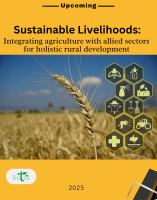 |
2025-03-26 03:03:14 |
Edit |
Delete |
| 7 |
|
|
Upcoming Book |
ID 26 Climate-Resilient Farming Practices: Adapting to climate change with innovative solutions |
Open Access Book |
Coming soon |
Coming soon |
Background
This book explores sustainable agricultural strategies designed to help farmers adapt to the challenges posed by climate change. It highlights innovative solutions that enhance resilience against extreme weather conditions, unpredictable rainfall patterns, and rising temperatures. The book provides insights into climate-smart agricultural practices, including soil conservation, water-efficient irrigation techniques, integrated pest management, and agroforestry. Emphasizing the importance of technology, the book discusses advancements such as AI-driven monitoring systems, precision farming, and the use of drought-resistant crop varieties. It also covers the role of organic farming, carbon sequestration, and nature-based solutions in reducing the environmental footprint of agriculture. Additionally, the book includes case studies of successful climate-resilient farming initiatives worldwide, showcasing how smallholders and large-scale farmers alike are implementing adaptive techniques. It offers practical guidance on policy frameworks, community engagement, and financial support mechanisms to ensure widespread adoption. With a focus on sustainability, innovation, and farmer-centric solutions, Climate-Resilient Farming Practices serves as a valuable resource for researchers, policymakers, and agricultural practitioners striving to build a more resilient food system in the face of climate change.
Tentative Titles/Themes of Chapter (New chapter titles may be proposed)
-
Farming in the Age of Climate Uncertainty
-
Decoding Climate Change: What It Means for Agriculture
-
When the Heavens Betray: Adapting to Erratic Rainfall
-
The Heat is On: Battling Rising Temperatures in Farming
-
Storms, Droughts, and Floods: Weatherproofing Agriculture
-
Soil on the Brink: Reviving the Foundation of Farming
-
Farming with Less Water: Smart Strategies for Dry Days
-
Carbon Farming: Turning Soil into a Climate Ally
-
Beyond the Plow: Conservation Agriculture for a Sustainable Future
-
Seeds of Resilience: Climate-Smart Crop Varieties
-
Water-Wise Farming: Rethinking Irrigation for the Future
-
Roots of Change: Agroforestry as a Climate Solution
-
From Waste to Wealth: Organic Farming in a Changing Climate
-
Farming Without Boundaries: Hydroponics and Vertical Agriculture
-
Green Gold: Cover Crops and Soil Regeneration
-
Precision Revolution: AI, Drones, and Smart Farming
-
The Silent Protectors: Beneficial Microbes and Biofertilizers
-
Climate-Proofing Farms with Crop Diversification
-
Bracing for Impact: Insurance and Risk Management for Farmers
-
AI Meets Agriculture: Predicting and Preventing Climate Shocks
-
The Future of Food: Lab-Grown Meat and Alternative Proteins
-
Farming the Seas: Climate-Smart Aquaculture Solutions
-
Smart Livestock Management: Keeping Animals Cool and Healthy
-
The Role of Pastures in Climate Adaptation
-
Silvopasture: Trees, Cattle, and a Greener Tomorrow
-
From Farm to Market: Building Climate-Resilient Supply Chains
-
Powering Farms with the Sun: Renewable Energy in Agriculture
-
The Green Shield: Natural Pest Control in a Warmer World
-
Rainwater Harvesting: Every Drop Counts
-
Climate Champions: Lessons from Farmers on the Frontlines
-
Cultivating Knowledge: The Role of Farmer Cooperatives
-
Women in Agriculture: Leading the Climate Resilience Movement
-
Indigenous Wisdom: Age-Old Farming Practices for a New Climate Era
-
Beyond Borders: Global Success Stories in Climate-Resilient Farming
-
The Economics of Resilient Farming: Profitability Meets Sustainability
-
Agriculture 4.0: The Digital Transformation of Farming
-
Pests on the Rise: Managing New Threats in a Warmer World
-
From Field to Forest: Rewilding Agriculture for Climate Adaptation
-
Disaster-Proofing Farms: Early Warning Systems and Preparedness
-
Climate Justice and Farming: Ensuring No Farmer is Left Behind
-
Food Security in a Changing World: The Road Ahead
-
Smart Policies for Smarter Farms: Government Interventions That Work
-
Eco-Friendly Fertilizers: Feeding Crops Without Harming the Planet
-
Agroecology: Working with Nature, Not Against It
-
Community Farming: The Power of Collective Resilience
-
The Role of Youth in Climate-Resilient Agriculture
-
Bridging the Gap: Science, Policy, and Farmer-Led Innovation
-
Scaling Up Climate Solutions: From Small Farms to Global Impact
-
The Future of Farming: What’s Next for Climate-Resilient Agriculture?
-
A Climate-Smart Tomorrow: The Path Forward for Farmers and Policymakers
CHAPTER SUBMISSION PROCEDURE:
Book Chapter may be submitted through e-mail: [email protected]
FOR ANY QUERIES:
Contact:+91-9863023086
Mail us: [email protected]
Authors' Guidelines Publication Package
|
|
IMPORTANT DATES:
- Chapter booking ends: 25th April, 2025
- Chapter submission ends: 25th May, 2025
CHAPTER SUBMISSION PROCEDURE:
Book Chapter may be submitted through e-mail: [email protected]
FOR ANY QUERIES:
Contact:+91-9863023086
Mail us: [email protected]
Authors' Guidelines Publication Package
|
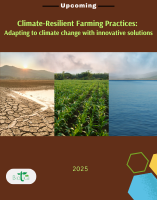 |
2025-03-26 02:52:52 |
Edit |
Delete |
| 8 |
|
|
Upcoming Book |
ID 23 Terminalia arjuna Bark Powder: A Promising Feed Additive for Sustainable and Healthy Fish Production |
Dharmendra Kumar Meena, Basanta Kumar Das, Amiya Kumar Sahoo |
Coming soon |
Coming soon |
Authored Book
Background
In the quest for sustainable and environmentally conscious aquaculture practices, a new book has emerged as a beacon of hope. "Terminalia arjuna Bark Powder: A Promising Feed Additive for Sustainable and Healthy Fish Production" is a comprehensive and meticulously researched volume that explores the potential of Terminalia arjuna bark powder as a natural feed additive in aquaculture. Edited by renowned experts in the field, Dr. Dharmendra Kumar Meena, Dr. Basanta Kumar, and Dr. Amiya Kumar Sahoo, this book is a testament to the power of interdisciplinary collaboration and the boundless potential of natural products in revolutionizing aquaculture practices. The authors' expertise in aquaculture, pharmacology, and botany shines through in the book's 12 chapters, which provide a rich tapestry of insights into the botany, traditional uses, phytochemistry, and pharmacological properties of Terminalia arjuna. The book begins by setting the stage for the urgent need for sustainable aquaculture practices, highlighting the alarming rate of environmental degradation and the escalating demand for seafood. The authors then delve into the potential benefits of Terminalia arjuna bark powder as a feed additive, including its ability to improve fish growth, reduce stress, and boost immunity.One of the book's greatest strengths is its commitment to bridging the gap between laboratory research and practical implementation. The authors provide a detailed examination of the scientific literature, coupled with their own research expertise, to explore the effects of Terminalia arjuna on fish growth, feed conversion ratios, stress response, and immunity. The inclusion of industry success stories and case studies serves as a powerful testament to the potential of this natural feed additive to transform the aquaculture landscape. The book also addresses safety and environmental concerns, standardization, and quality control, providing a roadmap for the commercial application of Terminalia arjuna bark powder in aquaculture. The authors' discussion of the regulatory landscape and compliance requirements for Terminalia arjuna-containing feeds is particularly noteworthy, as it highlights the importance of certification and market acceptance. Throughout the book, the authors' passion for sustainable aquaculture practices shines through, and their commitment to harnessing the power of science, innovation, and collaboration to create a more resilient, equitable, and environmentally conscious aquaculture industry is inspiring.
Editorial Board
Dr. Dharmendra Kumar Meena
Dr. Dharmendra Kumar Meena, Senior Scientist working at ICAR-Central Inland Fisheries Research Institute, Barrackpore, Kolkata, India. Dr. Meena has in his credit more than 60 international, 10 national peer reviewed articles, 30 book chapters, more than 50 popular articles. In addition, he is member of Editorial board of Research Biotica, Review Editor of Frontiers in Aquatic Physiology, sectional Editor, and World Journal of Food Science and Technology, Editorial Board member, Biotica Research Today (BRT), Editorial Board member Biotica journal, Editorial Board Member of Agriculture and Food Newsletter. Associate Editor International Journal of Zoological Investigation. Editor a book on Organic farming (Second Edition): Global Perspectives and Methods. Lead Guest Editor of ESPR Special issue on “Valorization of agroindustry and seafood waste towards blue economy: a waste to wealth concept”. Lead Guest Editor for a Special Issue on “Fisheries, Aquaculture and Agricultural Sustainability: Global Perspectives and Methods” in Biotica journal. Working as Topical Advisory Panel member of Fishes, water and life MDPI journals. Appointed as Academic Editor PLOSONE and Advances in Agriculture. Associate Editor International Aquatic Research, Food Science and Nutrition Technology, Aquaculture Science and Management. Guest editor in Frontiers in aquaculture. Also nominated as an editor Journal of Inland Fisheries Society of India (JIFSI) and Global Journal of Fisheries Science. Recently appointed as a Consulting Editor, Journal of Environmental Biology (JEB). Also joined as an Editorial Board Member Asian Journal of Fisheries and Aquatic Sciences (AJFAS). Also joined as EBM in Aquaculture International Journal, BMC Environmental Science, BMC Blue Biotechnology, BMC Aquaculture Science and Management, Discover Biotechnology, Discover Animal, NPJ sustainable Agriculture, Discover Foods. Dr. Meena conferred with Young Scientist Award from Academy of Environmental Biology, Fellow of Environmental Biology, Fellow of Fisheries and Life Sciences, Fellow of Society of Biotic and Environmental Research, Fellow of Zoological Society of India. Best Presentation awards in international and national forums. Dr. Meena is working more than 10 years on conversion of waste to wealth which is witnessed by his publication in high impact journals and also commercialized brewery waste-based fish feed, silk work pupae waste-based fish feed and developed Black solder fly (BSF) based fish feed technology. Dr. Meena acted as expert member of many high-level committee of Govt of India.
Contact No.7439313249, Email: [email protected]
Dr. Basanta Kumar Das
Dr. Basanta Kumar Das, Director, ICAR-CIFRI, Kolkata Born in Athilabaj, Balasore, Odisha on 20 March 1966. Educated at Orissa University of Agriculture and Technology, Ph.D. 1998, Post-Doc at FRS Marine Lab, Aberdeen, Scotland, UK 2006-2007. Professional Societies: President, Inland Fisheries Society of India to date; President, Professional Fisheries Graduates Forum and President, Orissa Fisheries College Alumni Association, International Society Environmental protection (ISEP); Member, Executive Council, Indian Science Congress Association for the year 2020-21; Member, The National Academy of Sciences, India; Life Member, Indian Science Congress Association. Research interests: 1. Disease Management in fish in open water ecosystem; 2. Health management in aquaculture; 3.Molecular epidemiological study of various fish diseases; 4. Anti-viral gene expression studies of carps; 5. Design and development of medicines against ornamental fish diseases; 6. Development of Immunostimulants and bioactive compounds from algae and plant derivatives, 7. Enclosure culture in inland open waters. Awards/Honours: Jawaharlal Nehru Award for outstanding post graduate research conferred by ICAR, I999; Lal Bahadur Shastri Young Scientist Award conferred by ICAR for the biennium 1999- 2000; Dr. M.S. Swaminathan Award for Best Indian Fisheries Scientist by Professional Fisheries Graduates Forum20 II; Krushi Ratna Award from Orissa Krushak Samaj 2016; Eminent Zoologist of the Year Award by Zoological Society of India 2017; Krushak Gourav Award from Orissa Krushak Samaj 2017; Ganesh Chandra Vidyarthi Award for Hindi Journal, Nilanjali, ICAR, New Delhi, 2018; Best annual Report Award of ICAR-CIFRI, ICAR, New Delhi, 2019; Sardar Patel Outstanding ICAR Institution Award-2020 under Large Institute Category, ICAR, New Delhi, 2020; Rafi Ahmed Kidwai Award for Outstanding Research in Agricultural Sciences under Animal & Fisheries Sciences Category, ICAR, New Delhi, 2020; Agri-Food Empowering India awards 2021; Prof G.K. Manna Memorial Award in 108th Session of Indian Science Congress, Nagpur in Jan 2023; Elected as President of the Section of Animal, Veterinary and Fishery Sciences.
Dr. Amiya Kumar Sahoo
Dr. Amiya Kumar Sahoo, is Senior Scientist at ICAR-Central Inland Fisheries Research Institute, Barrackpore, Kolkata. He obtained PhD in Aquaculture with specialisation on Fish Health at Karnataka Veterinary, Animal and Fisheries Science University in 2011. Since joining in Agricultural Research Service, he has been instrumental in Fish and River Health linking with National Mission Programmes including National Mission for Clean Ganga (NMCG), National Surveillance Programme on Aquatic Animal Diseases (NSPAAD). More recently, Dr. Sahoo is Principal Investigator of a multidisciplinary project on Antimicrobial Resistance (AMR) in Fisheries and Aquaculture under the technical guidance of FAO, which is of its first kind in India with a national identity of Indian Network on Fisheries and Animal Antimicrobial Resistance (INFAAR). Dr. Sahoo is member of Expert Appraisal Committee (EAC) of River Valley Projects, of MoEFCC since 2016. He is also a Technical member of ISO biodiversity TC331 committee and Technical member of CWC in Environmental flows and water management section. Dr. Sahoo is serving as Guest editors for Environmental Science and Pollution Research and Frontiers of Marine Science and as Editor in Chief of Journal of Inland Fisheries Society of India. Dr. Sahoo is a recipient of prestigious Fulbright Fellowship. He has received Best Scientist Award-2023, Distinguished Ichthyologist Award 2023, Padmashree S. Ayyapan Gold Medal 2022, Young Scientist Award and University Gold Medal. Dr. Sahoo has more than 80 research publications in peer reviewed journals with significant impacts in the area of fish diseases, environmental health particularly on river health and conservation of fishes. In this connection, Dr. Sahoo has both international and national association such as with Nofima, Norway, BFRI, Bangladesh, and Worldfish, Malaysia and with IITs. Dr. Sahoo has worked intensively associated with consultancy projects sponsored by NHPC, NTPC, Jindal, Bhilwara, NEEPCO, KPCL, IWAI, and CDA.
CHAPTER SUBMISSION PROCEDURE:
Book Chapter may be submitted through e-mail: [email protected]
FOR ANY QUERIES:
Contact:+91-9863023086
Mail us: [email protected]
Authors' Guidelines Publication Package
|
|
IMPORTANT DATES:
- Chapter submission ends: 15th April, 2025
CHAPTER SUBMISSION PROCEDURE:
Book Chapter may be submitted through e-mail: [email protected]
FOR ANY QUERIES:
Contact:+91-9863023086
Mail us: [email protected]
Authors' Guidelines Publication Package
|
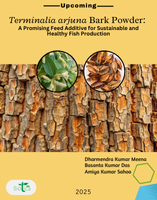 |
2025-03-01 10:17:57 |
Edit |
Delete |
| 9 |
|
|
Upcoming Book |
ID 22 Innovations in Aquaculture: Emerging Trends and Sustainable Practices |
D.K. Meena, Soibam Khogen Singh, Sachin Onkar Khairnar, Jham Lal, Girija Saurabh Behere, Sourabh Debbarma |
Coming soon |
Coming soon |
Background
The aquaculture industry is rapidly evolving to meet the demands of a growing global population, while also addressing the environmental and social challenges associated with traditional aquaculture practices. This book provides a comprehensive overview of the latest innovations and emerging trends in aquaculture, covering topics such as sustainable aquaculture systems, water quality management, and disease prevention and control. The book aims to provide a platform for knowledge sharing and collaboration among researchers, policymakers, and industry stakeholders to promote the development of a sustainable and responsible aquaculture industry.
List of Chapters:
- Technological Innovations in Aquaculture System Design
- Water Quality Management in Recirculating Aquaculture Systems
- Economic Feasibility and Scalability of Recirculating Systems
- Cutting-Edge Sensor Technologies for Real-Time Water Quality Monitoring
- Biological Indicators for Aquaculture Water Quality Management
- Integration of IoT and Data Analytics in Aquaculture Water Quality
- Carbon Footprint and Greenhouse Gas Emissions in Aquaculture
- Innovative Strategies for Waste Reduction and Recycling in Aquaculture
- Certification and Eco-Labelling for Sustainable Aquaculture Practices
- Nitrogen and Phosphorus Dynamics in Aquaculture: Principles and Applications
- Biotic and Abiotic Factors in Aquaculture Nutrient Management
- Innovative Nutrient Management Techniques for Sustainable Aquaculture
- Alternatives to Fishmeal and Fish Oil in Aquaculture Feeds
- Plant-Based and Insect-Based Feed Innovations in Aquaculture
- Cutting-Edge Feed Formulation and Production Techniques
- Vaccination and Immunostimulants in Aquaculture: Advances and Applications
- Pathogen Detection and Diagnostic Techniques in Aquaculture
- Quarantine and Biosecurity Measures in Modern Aquaculture
- Genome Editing and Applications in Aquaculture
- Genetic Mapping and Marker-Assisted Selection in Aquaculture
- Genetic Diversity and Ecosystem Stability in Aquaculture
- Conservation Strategies for Wild Populations in Aquaculture
- Enhancing Biodiversity Through Sustainable Habitat Management
Note:
- Chapter title may be modified or new chapter may also be proposed by the author.
- Green colour marked chapters are already booked
Lead Editor
Dr. D.K. Meena
Dr. D. K. Meena, Senior Scientist working at ICAR-Central Inland Fisheries Research Institute, Barrackpore, Kolkata, India. Dr. Meena has in his credit more than 60 international, 10 national peer reviewed articles, 30 book chapters, more than 50 popular articles. In addition, he is member of Editorial board of Research Biotica, Review Editor of Frontiers in Aquatic Physiology, sectional Editor, and World Journal of Food Science and Technology, Editorial Board member, Biotica Research Today (BRT), Editorial Board member Biotica journal, Editorial Board Member of Agriculture and Food Newsletter. Associate Editor International Journal of Zoological Investigation. Editor a book on Organic farming (Second Edition): Global Perspectives and Methods. Lead Guest Editor of ESPR Special issue on “Valorization of agroindustry and seafood waste towards blue economy: a waste to wealth concept”. Lead Guest Editor for a Special Issue on “Fisheries, Aquaculture and Agricultural Sustainability: Global Perspectives and Methods” in Biotica journal. Working as Topical Advisory Panel member of Fishes, water and life MDPI journals. Appointed as Academic Editor PLOSONE and Advances in Agriculture. Associate Editor International Aquatic Research, Food Science and Nutrition Technology, Aquaculture Science and Management. Guest editor in Frontiers in aquaculture. Also nominated as an editor Journal of Inland Fisheries Society of India (JIFSI) and Global Journal of Fisheries Science. Recently appointed as a Consulting Editor, Journal of Environmental Biology (JEB). Also joined as an Editorial Board Member Asian Journal of Fisheries and Aquatic Sciences (AJFAS). Also joined as EBM in Aquaculture International Journal, BMC Environmental Science, BMC Blue Biotechnology, BMC Aquaculture Science and Management, Discover Biotechnology, Discover Animal, NPJ sustainable Agriculture, Discover Foods. Dr. Meena conferred with Young Scientist Award from Academy of Environmental Biology, Fellow of Environmental Biology, Fellow of Fisheries and Life Sciences, Fellow of Society of Biotic and Environmental Research, Fellow of Zoological Society of India. Best Presentation awards in international and national forums. Dr. Meena is working more than 10 years on conversion of waste to wealth which is witnessed by his publication in high impact journals and also commercialized brewery waste-based fish feed, silk work pupae waste-based fish feed and developed Black solder fly (BSF) based fish feed technology. Dr. Meena acted as expert member of many high-level committee of Govt of India.
Associate Editors
Dr. Soibam Khogen Singh is currently working as Senior Scientist &Head of the Krishi Vigyan Kendra under the ICAR Research Complex for NEH Region, India. He completed his graduation from the Faculty of Fishery Science, West Bengal University of Animal and Fisheries Sciences, Kolkata, India, postgraduation from the Fisheries College and Research Institute, Tamil Nadu Veterinary and Animal Sciences University, Chennai, India, and doctoral degree from Central Institute of Fisheries Education, Mumbai, India. His area of research is alternative feed bio-resources, biofloc technology, fish immunology and culture of live food organisms. He has to his credit more than 35 peer reviewed research publications in high-impact journals. He is currently associated in 5 mega research projects, and also attained faculty foreign training at James Cook University, Singapore as a part of the IDP-NAHEP funded by the World Bank. He has been recognised by several national forums/organisations in the form of 3 awards.
Dr. Sachin Onkar Khairnar
Dr. Sachin Onkar Khairnar serves as an Associate Professor at the College of Fisheries, Bihar Animal Sciences University in Kishanganj. Prior to joining this institution, he held various positions at the College of Fisheries, Guru Angad Dev Veterinary and Animal Sciences University (Ludhiana), Central Institute of Freshwater Aquaculture (Bhubaneswar), and Fishery Survey of India (Mumbai). Dr. Khairnar obtained his PhD in Aquaculture from the Ocean University of China, Qingdao, and his M.F.Sc in Aquaculture from the College of Fisheries, Ratnagiri, Dr. Balasaheb Sawant Konkan Krishi Vidyapeeth, Dapoli, India. Dr Khairnar is an aquaculture expert with 13 years of experience in the breeding and rearing of indigenous and exotic varieties of carp, catfish, and ornamental fishes, as well as their feed, health, and water quality management. He is working on selective breeding, sex-reversal technology, improving fish pigmentation in ornamental fishes, and developing low-cost technologies for farmers. He has published over 50 research papers, guided 28 students as major and minor advisors, and developed low-cost ornamental fish culture and breeding units. He, along with his team, has successfully completed the ICAR-EL project on ornamental fishes in business mode at the College of Fisheries, Ludhiana, and was associate in NSPAAD at GADVASU (Ludhiana), and AICRP-PEASEM at PAU (Ludhiana). He has received several awards, including the Chinese Government Scholarship, the Young Scientist Award, and the Best Teacher Award.
Dr. Jham Lal
Dr. Jham Lal is working as assistant Professor with a notable publication record, including 4 book chapters, 2 research articles, and 27 popular articles. He has presented his work at 5 international and 5 national conferences, and has received several awards, including the Best Paper Presentation Award (2024), Best Research Scholar Award (2023), and Young Achiever Award (2023). He has also undergone training in Sophisticated Instruments (2022) and Ecology and Fisheries (2022), and possesses skills in Microsoft Office and SPSS Software. He is a member of several professional societies, including NESFA, ISAHRD, ATDS, and AEDS. Born on 06/09/1992, he is single and has a permanent address in Village-Masna, Mungeli, Chhattisgarh, with a correspondent address at ICAR-CIFRI, Barrackpore, Kolkata.
Dr. Girija Saurabh Behere
Dr. Girija Phadke-Behere is currently working as Assistant Professor in Fish Processing Technology Division in College of Fisheries, Datia, Rani Lakshmi Bai Central Agricultural University, Jhansi. She is distinguished in academics and researcher with a strong background in Fish Processing Technology. She holds a PhD from Karnataka Veterinary, Animal and Fisheries Sciences University, Bidar, and has received numerous awards and recognitions for her academic excellence, including the DST-INSPIRE Fellowship, Dr. Balasaheb Sawant Konkan Krishi Vidyapeeth Gold Medals, Research Excellence Award, Academic Excellence Award, Chancellor Award. With over 12 years of experience in research and extension, Dr. Behere has worked on various projects, including AICRP on Integrated Farming Systems, Development of pictorial guidelines for freshness of fish species, species-specific technologies for improved utilization of fishery resources, thermal and non-thermal technologies for processing and packaging of fish products, and innovative product development for value addition and nutrient fortification. She has published 30 research papers in international and national peer- reviewed journals, authored two books, edited one book and contributed to several book chapters/ manuals and having more than 30 popular articles to her credit. She organized over 200 harbour-based, dry fish development and seafood unit trainings for fishers, fisherwomen, focussing on fish quality management and sustainable fishing during her service in MPEDA-NETFISH. Also organized >15 workshops on Seafood value addition for livelihood generation. She also coordinated for a visit of Indian fishermen to the World Trade Organization in Geneva, Switzerland to advocate for fisheries subsidies and worked as Ornamental Fish Health Certification Officer for export of ornamental fish to various countries.
Mr. Sourabh Debbarma
Mr. Sourabh Debbarma obtained his degree of Bachelor of Fisheries Science (B.F.Sc.) in the year 2019 and Master of Fisheries Science (M.F.Sc.) in Aquatic Animal Health, in the year 2021 from College of Fisheries, Central Agricultural University (Imphal), Lembucherra, Tripura, India. He is currently pursuing his Ph.D. at Fisheries College and Research Institute, Tamil Nadu Dr. J. Jayalalithaa Fisheries University, Nagapattinam, Tamil Nadu. He worked for more than a year as a Junior Research Fellow under “Wolffia Project” which was funded by DBT, India, at the College of Fisheries, CAU (I) Lembucherra, Tripura (West), India. Also, he was given the Arup Nath Memorial Award and recognized as receiving the Best M.F.Sc. Thesis 2021 at the International Conference RASHI-2022.His works have published in several national and international journals comprising research articles, review articles, popular articles and book chapters.
CHAPTER SUBMISSION PROCEDURE:
Book Chapter may be submitted through e-mail: [email protected]
FOR ANY QUERIES:
Contact:+91-9863023086
Mail us: [email protected]
Authors' Guidelines Publication Package
|
|
IMPORTANT DATES:
- Chapter booking ends: 15th March, 2025
- Chapter submission ends: 15th April, 2025
CHAPTER SUBMISSION PROCEDURE:
Book Chapter may be submitted through e-mail: [email protected]
FOR ANY QUERIES:
Contact:+91-9863023086
Mail us: [email protected]
Authors' Guidelines Publication Package
|
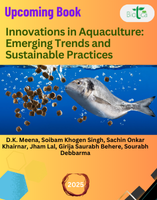 |
2025-02-26 15:40:44 |
Edit |
Delete |
| 10 |
|
|
Upcoming Book |
ID 20 Sustainable Aquaculture: Concepts & Benefits |
D.K. Meena, Binod Choudhury, Sachin Onkar Khairnar, Soibam Khogen Singh, Nitesh Kumar Yadav, Sourabh Debbarma |
Coming soon |
Coming soon |
Background
The world's population is projected to reach 9.7 billion by 2050, putting immense pressure on the global food system to produce more food while minimizing its environmental footprint. Aquaculture, the practice of farming aquatic animals and plants, has emerged as a vital component of the global food system, providing a sustainable source of protein for millions of people. However, the rapid growth of the aquaculture industry has also raised concerns about its environmental and social impacts. In response to these challenges, the concept of sustainable aquaculture has gained significant attention in recent years. Sustainable aquaculture refers to the practice of farming aquatic animals and plants in a way that minimizes harm to the environment, conserves natural resources, and promotes social responsibility. This book provides a comprehensive overview of sustainable aquaculture practices, covering various themes and topics that are essential for the development of a sustainable and responsible aquaculture industry. The book is divided into 6 themes, each consisting of three chapters that delve into the concepts, benefits, and best practices of sustainable aquaculture. The themes cover a range of topics, including integrated multi-trophic aquaculture, land-based systems, saline environments, cage aquaculture, animal health and welfare, and climate change. The book also explores the social and economic benefits of sustainable aquaculture, including its potential to provide livelihoods for millions of people and contribute to food security. The book is intended for a wide range of audiences, including aquaculture practitioners, researchers, policymakers, and students. It provides a valuable resource for anyone interested in learning about sustainable aquaculture practices and their potential to contribute to a more sustainable and food-secure future.
List of Chapters
- Integrated Multi-Trophic Aquaculture: Concepts and Case Studies
- Economic and Environmental Benefits of IMTA Systems
- Designing and Optimizing Efficient IMTA Systems: Innovations and Insights
- Land-Based Aquaculture: Closed Recirculating Systems (RAS) and Beyond
- Advances in Integrating Aquaponics and Hydroponics for Sustainable Aquaculture
- Innovative Water Recycling and Waste Management in Land-Based Aquaculture
- Navigating Saline Environments: Aquaculture Challenges and Innovations
- Saline-Tolerant Species: Opportunities and Management Strategies
- Successful Case Studies of Aquaculture in Salt-Affected Areas
- Cage Aquaculture: Environmental Impact and Management
- Innovations in Cage Design and Sustainable Materials
- Best Practices for Cage Aquaculture Maintenance and Management
- Health Monitoring and Diagnostic Tools for Aquatic Animals
- Prophylactic and Therapeutic Treatments in Aquaculture
- Welfare Standards and Ethical Considerations in Aquaculture
- Climate Resilience in Aquaculture: Species and Systems
- Predictive Modelling for Climate Impact Assessment in Aquaculture
- Policy and Governance for Climate Adaptation in Aquaculture
Note:
- Chapter title may be modified or new chapter may also be proposed by the author.
- Green colour marked chapters are already booked
Lead Editor
Dr. D.K. Meena
Dr. D. K. Meena, Senior Scientist working at ICAR-Central Inland Fisheries Research Institute, Barrackpore, Kolkata, India. Dr. Meena has in his credit more than 60 international, 10 national peer reviewed articles, 30 book chapters, more than 50 popular articles. In addition, he is member of Editorial board of Research Biotica, Review Editor of Frontiers in Aquatic Physiology, sectional Editor, and World Journal of Food Science and Technology, Editorial Board member, Biotica Research Today (BRT), Editorial Board member Biotica journal, Editorial Board Member of Agriculture and Food Newsletter. Associate Editor International Journal of Zoological Investigation. Editor a book on Organic farming (Second Edition): Global Perspectives and Methods. Lead Guest Editor of ESPR Special issue on “Valorization of agroindustry and seafood waste towards blue economy: a waste to wealth concept”. Lead Guest Editor for a Special Issue on “Fisheries, Aquaculture and Agricultural Sustainability: Global Perspectives and Methods” in Biotica journal. Working as Topical Advisory Panel member of Fishes, water and life MDPI journals. Appointed as Academic Editor PLOSONE and Advances in Agriculture. Associate Editor International Aquatic Research, Food Science and Nutrition Technology, Aquaculture Science and Management. Guest editor in Frontiers in aquaculture. Also nominated as an editor Journal of Inland Fisheries Society of India (JIFSI) and Global Journal of Fisheries Science. Recently appointed as a Consulting Editor, Journal of Environmental Biology (JEB). Also joined as an Editorial Board Member Asian Journal of Fisheries and Aquatic Sciences (AJFAS). Also joined as EBM in Aquaculture International Journal, BMC Environmental Science, BMC Blue Biotechnology, BMC Aquaculture Science and Management, Discover Biotechnology, Discover Animal, NPJ sustainable Agriculture, Discover Foods. Dr. Meena conferred with Young Scientist Award from Academy of Environmental Biology, Fellow of Environmental Biology, Fellow of Fisheries and Life Sciences, Fellow of Society of Biotic and Environmental Research, Fellow of Zoological Society of India. Best Presentation awards in international and national forums. Dr. Meena is working more than 10 years on conversion of waste to wealth which is witnessed by his publication in high impact journals and also commercialized brewery waste-based fish feed, silk work pupae waste-based fish feed and developed Black solder fly (BSF) based fish feed technology. Dr. Meena acted as expert member of many high-level committee of Govt of India.
Associate Editors
Dr. Binod Choudhury
Dr. Binod Kumar Choudhary is a Principal Scientist (Fish & Fisheries Sciences) at ICAR-NIBSM, Raipur, with 17 years of experience in research and development in ICAR institutions. He holds a Ph.D. in Fisheries Biotechnology from ICAR-CIFE, Mumbai, an M.F.Sc. in Fish Genetics and Biotechnology from ICAR-CIFE, Mumbai, and a B.F.Sc. from College of Fisheries, Mangalore (UAS, Bangalore). His research expertise includes fish genetics, biotechnology, and disease management, and he has developed standard protocols for selective breeding of rohu and sequenced whole mitochondrial genome of rohu and mrigal. He has also isolated and characterized bacterial pathogens from fish and animals, including first reports of Raoultella ornithinolytica and Chromobacterium species from India. Additionally, he has developed an automated computational pipeline for identifying microsatellites in mitochondrial genomes. Dr. Choudhary has authored over 50 research publications, including research papers, review articles, and book chapters, and has published in peer-reviewed journals such as Current Science and Mitochondrion. He has received several awards and recognition, including the Young Scientist Award from Society of Biological Sciences and Rural Development, Allahabad, Best Poster Presentation Award in X Agricultural Science Congress and 9th Indian Fisheries Forum, Best Research Paper Award from ICAR-NIBSM, Raipur, and Best Scientist Institutional Award of ICAR-NIBSM, Raipur.
Dr. Sachin Onkar Khairnar
Dr. Sachin Onkar Khairnar serves as an Associate Professor at the College of Fisheries, Bihar Animal Sciences University in Kishanganj. Prior to joining this institution, he held various positions at the College of Fisheries, Guru Angad Dev Veterinary and Animal Sciences University (Ludhiana), Central Institute of Freshwater Aquaculture (Bhubaneswar), and Fishery Survey of India (Mumbai). Dr. Khairnar obtained his PhD in Aquaculture from the Ocean University of China, Qingdao, and his M.F.Sc in Aquaculture from the College of Fisheries, Ratnagiri, Dr. Balasaheb Sawant Konkan Krishi Vidyapeeth, Dapoli, India. Dr Khairnar is an aquaculture expert with 13 years of experience in the breeding and rearing of indigenous and exotic varieties of carp, catfish, and ornamental fishes, as well as their feed, health, and water quality management. He is working on selective breeding, sex-reversal technology, improving fish pigmentation in ornamental fishes, and developing low-cost technologies for farmers. He has published over 50 research papers, guided 28 students as major and minor advisors, and developed low-cost ornamental fish culture and breeding units. He, along with his team, has successfully completed the ICAR-EL project on ornamental fishes in business mode at the College of Fisheries, Ludhiana, and was associate in NSPAAD at GADVASU (Ludhiana), and AICRP-PEASEM at PAU (Ludhiana). He has received several awards, including the Chinese Government Scholarship, the Young Scientist Award, and the Best Teacher Award.
Dr. Soibam Khogen Singh
Dr. Soibam Khogen Singh is currently working as Senior Scientist &Head of the Krishi Vigyan Kendra under the ICAR Research Complex for NEH Region, India. He completed his graduation from the Faculty of Fishery Science, West Bengal University of Animal and Fisheries Sciences, Kolkata, India, postgraduation from the Fisheries College and Research Institute, Tamilnadu Veterinary and Animal Sciences University, Chennai, India, and doctoral degree from Central Institute of Fisheries Education, Mumbai, India. His area of research is alternative feed bio-resources, biofloc technology, fish immunology and culture of live food organisms. He has to his credit more than 35 peer reviewed research publications in high-impact journals. He is currently associated in 5 mega research projects, and also attained faculty foreign training at James Cook University, Singapore as a part of the IDP-NAHEP funded by the World Bank. He has been recognised by several national forums/organisations in the form of 3 awards.
Mr. Nitesh Kumar Yadav
Mr. Nitesh Kumar Yadav is a Researcher in Department of Aquaculture at the College of Fisheries, CAU (I), Agartala, India. He holds a Master's degree in Aquaculture and a Bachelor's degree in Fisheries Science from MPUAT, Udaipur, Rajasthan. With a strong academic background, Nitesh has demonstrated exceptional talent and commitment, earning accolades such as the Young Achiever Award, Excellence Award, and Best Oral Presentation Award at international conferences. He has also published over 40 scientific publications, including research articles, reviews, and book chapters, in prestigious national and international journals. As a Teaching Assistant and Research Fellow, Nitesh has gained valuable experience in teaching, research, and aquaculture practices. His research interests include aquatic species metabolism, stress response, and fish nutrition. With a strong passion for advancing aquaculture, Nitesh is committed to contributing to the global scientific community and promoting sustainable aquaculture practices.
Mr. Sourabh Debbarma
Mr. Sourabh Debbarma obtained his degree of Bachelor of Fisheries Science (B.F.Sc.) in the year 2019 and Master of Fisheries Science (M.F.Sc.) in Aquatic Animal Health, in the year 2021 from College of Fisheries, Central Agricultural University (Imphal), Lembucherra, Tripura, India. He is currently pursuing his Ph.D. at Fisheries College and Research Institute, Tamil Nadu Dr. J. Jayalalithaa Fisheries University, Nagapattinam, Tamil Nadu. He worked for more than a year as a Junior Research Fellow under “Wolffia Project” which was funded by DBT, India, at the College of Fisheries, CAU (I) Lembucherra, Tripura (West), India. Also, he was given the Arup Nath Memorial Award and recognized as receiving the Best M.F.Sc. Thesis 2021 at the International Conference RASHI-2022.His works have published in several national and international journals comprising research articles, review articles, popular articles and book chapters.
CHAPTER SUBMISSION PROCEDURE:
Book Chapter may be submitted through e-mail: [email protected]
FOR ANY QUERIES:
Contact:+91-9863023086
Mail us: [email protected]
Authors' Guidelines Publication Package
|
|
IMPORTANT DATES:
- Chapter booking ends: 15th March, 2025
- Chapter submission ends: 15th April, 2025
CHAPTER SUBMISSION PROCEDURE:
Book Chapter may be submitted through e-mail: [email protected]
FOR ANY QUERIES:
Contact:+91-9863023086
Mail us: [email protected]
Authors' Guidelines Publication Package
|
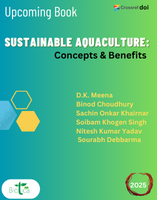 |
2025-02-25 17:09:11 |
Edit |
Delete |
| 11 |
|
|
Upcoming Book |
ID 19 Innovations in Sustainable Aquaculture: Emerging Trends and Best Practices |
D.K. Meena, Girija Saurabh Behere, Naresh Mehta, Sudhanshu Raman, Jham Lal, Shimanku Borah |
Coming soon |
Coming soon |
Background
The aquaculture industry is facing numerous challenges, including environmental degradation, water pollution, and climate change, which threaten the sustainability of this vital food source. In response, researchers and practitioners are developing innovative solutions to address these challenges and promote sustainable aquaculture practices. This book provides a comprehensive overview of the latest trends and best practices in sustainable aquaculture, covering topics such as aquaponics, algae-based bioremediation, microbiomes, bioengineering, and circular economy concepts. The book aims to provide a platform for knowledge sharing and collaboration among researchers, policymakers, and industry stakeholders to promote the development of a sustainable and responsible aquaculture industry.
List of Chapters:
- Integrating Aquaculture and Hydroponics: Aquaponics Systems
- Benefits of Aquaponics for Food Security and Sustainability
- Design and Management of Innovative Aquaponics Systems
- Nutritional Benefits and Applications of Algae in Aquaculture Feeds
- Algae-Based Bioremediation Techniques for Water Quality Management
- Innovations in Algal Cultivation for Sustainable Aquaculture
- Advanced Wastewater Treatment Technologies in Aquaculture
- Regulatory Requirements and Compliance for Effluent Management
- Sustainable Practices for Effluent Management in Aquaculture
- Microbial Diversity and Function in Aquaculture Systems
- Innovations in Probiotics and Microbial Management for Aquaculture
- Applications of Microbiomes in Disease Prevention and Growth Enhancement
- Genetic Engineering and Synthetic Biology in Aquaculture
- Nanomaterials for Water Treatment and Disease Control in Aquaculture
- Ethical and Environmental Considerations in Bioengineering and Nanotechnology
- Resource Efficiency and Waste Minimization in Aquaculture
- Recycling and Reuse Strategies for Sustainable Aquaculture
- Case Studies of Circular Economy Practices in Aquaculture
- Techniques for Minimizing Stress and Mortality During Harvesting
- Post-Harvest Handling and Processing Innovations in Aquaculture
- Advancements in Cold Chain Management for Aquaculture Products
- Vision for the Future of Sustainable Aquaculture Practices
- Pathways for Continued Research and Innovation in Aquaculture
- Application of eDNA in assessing and monitoring of fish diseases
- Applications of Transcriptomics in Fish Genetics Research for sustainable aquaculture production
- Resource Efficiency and Waste Minimization in Aquaculture
- Recent Novel Feeds and Feeding Techniques for reducing feed waste in aquaculture
- Case Studies of Circular Economy Practices in Aquaculture
- Techniques for Minimizing Stress and Mortality During Harvesting
Note:
- Chapter title may be modified or new chapter may also be proposed by the author.
- Green colour marked chapters are already booked
Lead editor:
Dr. D. K. Meena
Dr. D. K. Meena, Senior Scientist working at ICAR-Central Inland Fisheries Research Institute, Barrackpore, Kolkata, India. Dr. Meena has in his credit more than 60 international, 10 national peer reviewed articles, 30 book chapters, more than 50 popular articles. In addition, he is member of Editorial board of Research Biotica, Review Editor of Frontiers in Aquatic Physiology, sectional Editor, and World Journal of Food Science and Technology, Editorial Board member, Biotica Research Today (BRT), Editorial Board member Biotica journal, Editorial Board Member of Agriculture and Food Newsletter. Associate Editor International Journal of Zoological Investigation. Editor a book on Organic farming (Second Edition): Global Perspectives and Methods. Lead Guest Editor of ESPR Special issue on “Valorization of agroindustry and seafood waste towards blue economy: a waste to wealth concept”. Lead Guest Editor for a Special Issue on “Fisheries, Aquaculture and Agricultural Sustainability: Global Perspectives and Methods” in Biotica journal. Working as Topical Advisory Panel member of Fishes, water and life MDPI journals. Appointed as Academic Editor PLOSONE and Advances in Agriculture. Associate Editor International Aquatic Research, Food Science and Nutrition Technology, Aquaculture Science and Management. Guest editor in Frontiers in aquaculture. Also nominated as an editor Journal of Inland Fisheries Society of India (JIFSI) and Global Journal of Fisheries Science. Recently appointed as a Consulting Editor, Journal of Environmental Biology (JEB). Also joined as an Editorial Board Member Asian Journal of Fisheries and Aquatic Sciences (AJFAS). Also joined as EBM in Aquaculture International Journal, BMC Environmental Science, BMC Blue Biotechnology, BMC Aquaculture Science and Management, Discover Biotechnology, Discover Animal, NPJ sustainable Agriculture, Discover Foods. Dr. Meena conferred with Young Scientist Award from Academy of Environmental Biology, Fellow of Environmental Biology, Fellow of Fisheries and Life Sciences, Fellow of Society of Biotic and Environmental Research, Fellow of Zoological Society of India. Best Presentation awards in international and national forums. Dr. Meena is working more than 10 years on conversion of waste to wealth which is witnessed by his publication in high impact journals and also commercialized brewery waste-based fish feed, silk work pupae waste-based fish feed and developed Black solder fly (BSF) based fish feed technology. Dr. Meena acted as expert member of many high-level committee of Govt of India.
Associate Editors
Dr. Girija Saurabh Behere
Dr. Girija Phadke-Behere is currently working as Assistant Professor in Fish Processing Technology Division in College of Fisheries, Datia, Rani Lakshmi Bai Central Agricultural University, Jhansi. She is distinguished in academics and researcher with a strong background in Fish Processing Technology. She holds a PhD from Karnataka Veterinary, Animal and Fisheries Sciences University, Bidar, and has received numerous awards and recognitions for her academic excellence, including the DST-INSPIRE Fellowship, Dr. Balasaheb Sawant Konkan Krishi Vidyapeeth Gold Medals, Research Excellence Award, Academic Excellence Award, Chancellor Award. With over 12 years of experience in research and extension, Dr. Behere has worked on various projects, including AICRP on Integrated Farming Systems, Development of pictorial guidelines for freshness of fish species, species-specific technologies for improved utilization of fishery resources, thermal and non-thermal technologies for processing and packaging of fish products, and innovative product development for value addition and nutrient fortification. She has published 30 research papers in international and national peer-reviewed journals, authored two books, edited one book and contributed to several book chapters/ manuals and having more than 30 popular articles to her credit. She organized over 200 harbour-based, dry fish development and seafood unit trainings for fishers, fisherwomen, focussing on fish quality management and sustainable fishing during her service in MPEDA-NETFISH. Also organized >15 workshops on Seafood value addition for livelihood generation. She also coordinated for a visit of Indian fishermen to the World Trade Organization in Geneva, Switzerland to advocate for fisheries subsidies and worked as Ornamental Fish Health Certification Officer for export of ornamental fish to various countries.
Dr. Naresh Mehta
Dr. Naresh Kumar Mehta is a renowned expert in the field of fisheries and aquaculture, with a Ph.D. in Fish Processing Technology from Central Institute of Fisheries Education (CIFE), Mumbai. He has a strong research background, with a focus on fish processing technology, value addition, and waste management, and has published several research papers in national and international journals. Dr. Mehta has received several awards and recognition for his work, including the Young Scientist Award-2020 in the field of Fish Processing Technology and the Best PhD Thesis Award for the academic year 2016-17 from CIFE, Mumbai. He has also received Senior Research Fellowship (SRF) and Junior Research Fellowship (JRF) from Indian Council of Agricultural Research (ICAR). Currently, Dr. Mehta is working as an Assistant Professor at College of Fisheries, Central Agricultural University (CAU), Lembucherra, Tripura, and has organized several training programs and workshops on fish processing technology and value addition. He has also delivered a radio talk on "Possibilities of Fish Culture in Banswara District" on All India Radio, Banswara.
Dr. Sudhanshu Raman
Dr. Sudhanshu Raman is a distinguished professional in the field of fish nutrition and feed technology, currently holding the position of Assistant Professor at the College of Fisheries, Central Agricultural University (CAU), Jhansi. He earned his Ph.D. in Fish Nutrition and Feed Technology from the prestigious ICAR-Central Institute of Fisheries Education (Deemed University), Mumbai, in 2021, further strengthening his academic foundation with a Master’s degree in Fish Biotechnology from the same institution.Dr. Raman has built a versatile career, combining academic research with hands-on involvement in developmental projects aimed at enhancing fisheries and aquaculture in India. Since 2017, he has served as a Consultant at the National Fisheries Development Board (NFDB), Hyderabad, where he played a pivotal role in managing and executing key fisheries development programs. His expertise also extended to his role as Deputy State Programme Manager with the Assam State Fisheries Department, where he oversaw numerous fisheries projects in the Northeastern region of India, with a particular focus on cold water fisheries, aquatic animal health, and technological innovations.Dr. Raman has been instrumental in driving NFDB’s Technology Upgradation projects, working on state-of-the-art developments in aquaculture infrastructure. He also played a leading role in the establishment of Aqua One Centers and the Aquatic Animal Health Laboratory, aimed at improving the health and productivity of aquatic species in the region. Additionally, his international collaborations are noteworthy, as he was part of an Indian delegation to Denmark, exploring partnerships to enhance cold water fisheries in India, a vital area for sustainable fish farming in the country.With a robust research background, Dr. Raman has published extensively in national and international journals, contributing significantly to the advancement of knowledge in fish nutrition, aquaculture, and biotechnology. His research has not only been recognized for its academic value but also for its real-world applications, aimed at improving sustainable fisheries practices. Through his work, Dr. Raman continues to influence both the academic community and the fisheries industry, promoting innovations that are essential for the growth of aquaculture in India and beyond.
Dr. Jham Lal
Dr. Jham Lal is working as assistant Professor with a notable publication record, including 4 book chapters, 2 research articles, and 27 popular articles. He has presented his work at 5 international and 5 national conferences, and has received several awards, including the Best Paper Presentation Award (2024), Best Research Scholar Award (2023), and Young Achiever Award (2023). He has also undergone training in Sophisticated Instruments (2022) and Ecology and Fisheries (2022), and possesses skills in Microsoft Office and SPSS Software. He is a member of several professional societies, including NESFA, ISAHRD, ATDS, and AEDS. Born on 06/09/1992, he is single and has a permanent address in Village-Masna, Mungeli, Chhattisgarh, with a correspondent address at ICAR-CIFRI, Barrackpore, Kolkata.
Dr. Shimanku Borah
Dr. Simanku Borah is a Scientist at the Regional Centre, ICAR-Central Inland Fisheries Research Institute, Guwahati. He holds a Ph.D. in Fisheries Resource Management from ICAR-CIFE, Mumbai, and an M.F.Sc. in Fisheries Resource Management from the same institution. Dr. Borah has research experience in inland fisheries management and has worked on various projects, including those funded by the National Statistical Office, Ministry of Statistics and Programme Implementation, Government of India, and WorldFish, Penang, Malaysia. He has published over 40 research papers in national and international journals and has presented papers at conferences and seminars. Dr. Borah has also received several awards, including the Young Scientist Award-2020 in the field of Fish Processing Technology. He is currently working on projects related to fisheries and aquaculture, including the assessment of fisheries and ecology in the Kameng basin of Arunachal Pradesh.
CHAPTER SUBMISSION PROCEDURE:
Book Chapter may be submitted through e-mail: [email protected]
FOR ANY QUERIES:
Contact:+91-9863023086
Mail us: [email protected]
Authors' Guidelines Publication Package
|
Lead editor:
Dr. D. K. Meena
Dr. D. K. Meena, Senior Scientist working at ICAR-Central Inland Fisheries Research Institute, Barrackpore, Kolkata, India. Dr. Meena has in his credit more than 60 international, 10 national peer reviewed articles, 30 book chapters, more than 50 popular articles. In addition, he is member of Editorial board of Research Biotica, Review Editor of Frontiers in Aquatic Physiology, sectional Editor, and World Journal of Food Science and Technology, Editorial Board member, Biotica Research Today (BRT), Editorial Board member Biotica journal, Editorial Board Member of Agriculture and Food Newsletter. Associate Editor International Journal of Zoological Investigation. Editor a book on Organic farming (Second Edition): Global Perspectives and Methods. Lead Guest Editor of ESPR Special issue on “Valorization of agroindustry and seafood waste towards blue economy: a waste to wealth concept”. Lead Guest Editor for a Special Issue on “Fisheries, Aquaculture and Agricultural Sustainability: Global Perspectives and Methods” in Biotica journal. Working as Topical Advisory Panel member of Fishes, water and life MDPI journals. Appointed as Academic Editor PLOSONE and Advances in Agriculture. Associate Editor International Aquatic Research, Food Science and Nutrition Technology, Aquaculture Science and Management. Guest editor in Frontiers in aquaculture. Also nominated as an editor Journal of Inland Fisheries Society of India (JIFSI) and Global Journal of Fisheries Science. Recently appointed as a Consulting Editor, Journal of Environmental Biology (JEB). Also joined as an Editorial Board Member Asian Journal of Fisheries and Aquatic Sciences (AJFAS). Also joined as EBM in Aquaculture International Journal, BMC Environmental Science, BMC Blue Biotechnology, BMC Aquaculture Science and Management, Discover Biotechnology, Discover Animal, NPJ sustainable Agriculture, Discover Foods. Dr. Meena conferred with Young Scientist Award from Academy of Environmental Biology, Fellow of Environmental Biology, Fellow of Fisheries and Life Sciences, Fellow of Society of Biotic and Environmental Research, Fellow of Zoological Society of India. Best Presentation awards in international and national forums. Dr. Meena is working more than 10 years on conversion of waste to wealth which is witnessed by his publication in high impact journals and also commercialized brewery waste-based fish feed, silk work pupae waste-based fish feed and developed Black solder fly (BSF) based fish feed technology. Dr. Meena acted as expert member of many high-level committee of Govt of India.
Associate Editors
Dr. Girija Saurabh Behere
Dr. Girija Phadke-Behere is currently working as Assistant Professor in Fish Processing Technology Division in College of Fisheries, Datia, Rani Lakshmi Bai Central Agricultural University, Jhansi. She is distinguished in academics and researcher with a strong background in Fish Processing Technology. She holds a PhD from Karnataka Veterinary, Animal and Fisheries Sciences University, Bidar, and has received numerous awards and recognitions for her academic excellence, including the DST-INSPIRE Fellowship, Dr. Balasaheb Sawant Konkan Krishi Vidyapeeth Gold Medals, Research Excellence Award, Academic Excellence Award, Chancellor Award. With over 12 years of experience in research and extension, Dr. Behere has worked on various projects, including AICRP on Integrated Farming Systems, Development of pictorial guidelines for freshness of fish species, species-specific technologies for improved utilization of fishery resources, thermal and non-thermal technologies for processing and packaging of fish products, and innovative product development for value addition and nutrient fortification. She has published 30 research papers in international and national peer-reviewed journals, authored two books, edited one book and contributed to several book chapters/ manuals and having more than 30 popular articles to her credit. She organized over 200 harbour-based, dry fish development and seafood unit trainings for fishers, fisherwomen, focussing on fish quality management and sustainable fishing during her service in MPEDA-NETFISH. Also organized >15 workshops on Seafood value addition for livelihood generation. She also coordinated for a visit of Indian fishermen to the World Trade Organization in Geneva, Switzerland to advocate for fisheries subsidies and worked as Ornamental Fish Health Certification Officer for export of ornamental fish to various countries.
Dr. Naresh Mehta
Dr. Naresh Kumar Mehta is a renowned expert in the field of fisheries and aquaculture, with a Ph.D. in Fish Processing Technology from Central Institute of Fisheries Education (CIFE), Mumbai. He has a strong research background, with a focus on fish processing technology, value addition, and waste management, and has published several research papers in national and international journals. Dr. Mehta has received several awards and recognition for his work, including the Young Scientist Award-2020 in the field of Fish Processing Technology and the Best PhD Thesis Award for the academic year 2016-17 from CIFE, Mumbai. He has also received Senior Research Fellowship (SRF) and Junior Research Fellowship (JRF) from Indian Council of Agricultural Research (ICAR). Currently, Dr. Mehta is working as an Assistant Professor at College of Fisheries, Central Agricultural University (CAU), Lembucherra, Tripura, and has organized several training programs and workshops on fish processing technology and value addition. He has also delivered a radio talk on "Possibilities of Fish Culture in Banswara District" on All India Radio, Banswara.
Dr. Sudhanshu Raman
Dr. Sudhanshu Raman is a distinguished professional in the field of fish nutrition and feed technology, currently holding the position of Assistant Professor at the College of Fisheries, Central Agricultural University (CAU), Jhansi. He earned his Ph.D. in Fish Nutrition and Feed Technology from the prestigious ICAR-Central Institute of Fisheries Education (Deemed University), Mumbai, in 2021, further strengthening his academic foundation with a Master’s degree in Fish Biotechnology from the same institution.Dr. Raman has built a versatile career, combining academic research with hands-on involvement in developmental projects aimed at enhancing fisheries and aquaculture in India. Since 2017, he has served as a Consultant at the National Fisheries Development Board (NFDB), Hyderabad, where he played a pivotal role in managing and executing key fisheries development programs. His expertise also extended to his role as Deputy State Programme Manager with the Assam State Fisheries Department, where he oversaw numerous fisheries projects in the Northeastern region of India, with a particular focus on cold water fisheries, aquatic animal health, and technological innovations.Dr. Raman has been instrumental in driving NFDB’s Technology Upgradation projects, working on state-of-the-art developments in aquaculture infrastructure. He also played a leading role in the establishment of Aqua One Centers and the Aquatic Animal Health Laboratory, aimed at improving the health and productivity of aquatic species in the region. Additionally, his international collaborations are noteworthy, as he was part of an Indian delegation to Denmark, exploring partnerships to enhance cold water fisheries in India, a vital area for sustainable fish farming in the country.With a robust research background, Dr. Raman has published extensively in national and international journals, contributing significantly to the advancement of knowledge in fish nutrition, aquaculture, and biotechnology. His research has not only been recognized for its academic value but also for its real-world applications, aimed at improving sustainable fisheries practices. Through his work, Dr. Raman continues to influence both the academic community and the fisheries industry, promoting innovations that are essential for the growth of aquaculture in India and beyond.
Dr. Jham Lal
Dr. Jham Lal is working as assistant Professor with a notable publication record, including 4 book chapters, 2 research articles, and 27 popular articles. He has presented his work at 5 international and 5 national conferences, and has received several awards, including the Best Paper Presentation Award (2024), Best Research Scholar Award (2023), and Young Achiever Award (2023). He has also undergone training in Sophisticated Instruments (2022) and Ecology and Fisheries (2022), and possesses skills in Microsoft Office and SPSS Software. He is a member of several professional societies, including NESFA, ISAHRD, ATDS, and AEDS. Born on 06/09/1992, he is single and has a permanent address in Village-Masna, Mungeli, Chhattisgarh, with a correspondent address at ICAR-CIFRI, Barrackpore, Kolkata.
Dr. Shimanku Borah
Dr. Simanku Borah is a Scientist at the Regional Centre, ICAR-Central Inland Fisheries Research Institute, Guwahati. He holds a Ph.D. in Fisheries Resource Management from ICAR-CIFE, Mumbai, and an M.F.Sc. in Fisheries Resource Management from the same institution. Dr. Borah has research experience in inland fisheries management and has worked on various projects, including those funded by the National Statistical Office, Ministry of Statistics and Programme Implementation, Government of India, and WorldFish, Penang, Malaysia. He has published over 40 research papers in national and international journals and has presented papers at conferences and seminars. Dr. Borah has also received several awards, including the Young Scientist Award-2020 in the field of Fish Processing Technology. He is currently working on projects related to fisheries and aquaculture, including the assessment of fisheries and ecology in the Kameng basin of Arunachal Pradesh.
|
IMPORTANT DATES:
- Chapter booking ends: 15th March, 2025
- Chapter submission ends: 15th April, 2025
CHAPTER SUBMISSION PROCEDURE:
Book Chapter may be submitted through e-mail: [email protected]
FOR ANY QUERIES:
Contact:+91-9863023086
Mail us: [email protected]
Authors' Guidelines Publication Package
|
 |
2025-02-25 17:06:43 |
Edit |
Delete |
| 12 |
|
|
Upcoming Book |
ID 28 Crop Defense Mechanisms: Insights into Biotic Stress Responses |
Open Access Book |
Coming soon |
Coming soon |
Background
Biotic stress significantly threatens global agriculture, impacting productivity and food security. The book provides a comprehensive exploration of the biological, molecular and ecological strategies plants use to combat stressors like pests, pathogens and weeds. It covers fundamental concepts such as phytohormones, signal transduction pathways, systemic acquired resistance and secondary metabolites. The book highlights cutting-edge innovations, including CRISPR-Cas9 genome editing, RNA interference, synthetic biology and nanotechnology, offering advanced tools for enhancing crop resilience. It also emphasizes sustainable practices like biocontrol agents, plant growth-promoting rhizobacteria and integrated pest management to align with ecological and economic goals. Addressing critical challenges such as climate change, pesticide resistance and emerging pathogens, the book provides actionable insights into breeding climate-resilient crops. It also explores functional genomics, proteomics and AI-driven tools for precise pest and disease management. Tailored for researchers, academicians and policymakers, this book bridges science and practice, offering a roadmap for sustainable agriculture. "Crop Defense Mechanisms" serves as a valuable resource for advancing efforts to mitigate biotic stresses and secure global food systems in an era of unprecedented challenges.
Tentative Titles/Themes of Chapter (New chapter titles may be proposed)
Theme 1: Fundamentals of Biotic Stress
Chapter 1: Introduction to Biotic Stress in Agriculture
Chapter 2: Classification and Types of Biotic Stress: Pests, Pathogens, and Weeds
Chapter 3: Plant-Pathogen Interactions: An Overview
Chapter 4: Molecular Basis of Plant Defense Mechanisms
Chapter 5: Role of Phytohormones in Biotic Stress Responses
Chapter 6: Oxidative Stress and Antioxidant Defense in Plants
Chapter 7: Gene-for-Gene Hypothesis in Crop Resistance
Chapter 8: Role of Microbiomes in Plant Biotic Stress Tolerance
Chapter 9: Signal Transduction Pathways in Biotic Stress Responses
Chapter 10: Advances in Understanding Plant Immunity
Theme 2: Crop Defense Mechanisms
Chapter 11: Systemic Acquired Resistance (SAR) in Plants
Chapter 12: Induced Systemic Resistance (ISR) by Beneficial Microbes
Chapter 13: Role of Secondary Metabolites in Biotic Stress Management
Chapter 14: R-Genes and Their Role in Disease Resistance
Chapter 15: Role of Plant Cuticle and Cell Walls in Defense
Chapter 16: Crosstalk Between Abiotic and Biotic Stress Responses
Chapter 17: Effector-Triggered Immunity (ETI) in Plants
Chapter 18: Role of Calcium Signaling in Plant Defense Mechanisms
Chapter 19: Importance of Epigenetics in Biotic Stress Tolerance
Chapter 20: Small RNAs and Their Role in Plant Defense
Theme 3: Recent Advances in Biotic Stress Research
Chapter 21: CRISPR-Cas9 in Developing Biotic Stress-Resilient Crops
Chapter 22: Role of Proteomics and Metabolomics in Understanding Plant Defense
Chapter 23: Transgenic Crops for Enhanced Biotic Stress Tolerance
Chapter 24: RNA Interference (RNAi) for Pest and Pathogen Management
Chapter 25: Nanotechnology in Biotic Stress Management
Chapter 26: Use of Endophytes for Sustainable Biotic Stress Management
Chapter 27: Advances in Genome Editing for Biotic Stress Tolerance
Chapter 28: AI-Based Systems for Pest and Disease Prediction
Chapter 29: Synthetic Biology in Developing Biotic Stress-Resistant Crops
Chapter 30: Functional Genomics of Biotic Stress in Major Crops
Theme 4: Sustainable Management Approaches
Chapter 31: Integrated Pest Management in Biotic Stress Mitigation
Chapter 32: Biocontrol Agents for Crop Protection
Chapter 33: Role of Plant Growth-Promoting Rhizobacteria (PGPR) in Biotic Stress
Chapter 34: Organic Farming Practices for Biotic Stress Management
Chapter 35: Natural Plant Extracts as Biopesticides
Chapter 36: Role of Trap Cropping in Pest Management
Chapter 37: Use of Companion Planting for Disease and Pest Suppression
Chapter 38: Importance of Healthy Nursery Raising in Disease-Free Cultivation
Chapter 39: Harnessing Indigenous Knowledge for Biotic Stress Management
Chapter 40: Decision Support Systems for Crop Health Management
Theme 5: Emerging Challenges and Future Prospects
Chapter 41: Climate Change and Its Impact on Biotic Stress
Chapter 42: Emerging Pests and Pathogens in a Changing Climate
Chapter 43: Herbicide and Pesticide Resistance: Challenges and Solutions
Chapter 44: Role of Biodiversity in Enhancing Biotic Stress Resilience
Chapter 45: Developing Climate-Resilient Crops with Biotic Stress Resistance
Chapter 46: Innovations in Pest and Disease Surveillance Systems
Chapter 47: Policies and Regulations for Biotic Stress Management in Agriculture
Chapter 48: Future Prospects of AI and IoT in Biotic Stress Management
Chapter 49: Bridging the Gap Between Laboratory Research and Field Applications
Chapter 50: Building Global Collaboration for Research on Biotic Stress Management
**Chapter title may be modified or new chapter may also be proposed by the author.
CHAPTER SUBMISSION PROCEDURE:
Book Chapter may be submitted through e-mail: [email protected]
FOR ANY QUERIES:
Contact:+91-9863023086
Mail us: [email protected]
Authors' Guidelines Publication Package
|
|
IMPORTANT DATES:
- Chapter booking ends: 25th April, 2025
- Chapter submission ends: 25th May, 2025
CHAPTER SUBMISSION PROCEDURE:
Book Chapter may be submitted through e-mail: [email protected]
FOR ANY QUERIES:
Contact:+91-9863023086
Mail us: [email protected]
Authors' Guidelines Publication Package
|
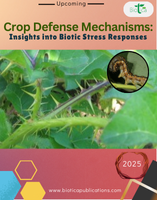 |
2025-03-29 08:28:20 |
Edit |
Delete |
| 13 |
|
|
Online Book |
Cutting-Edge Research in Sericulture: Enhancing Productivity and Quality |
N. Sakthivel, Ramakrishna Naika, B. Sannappa, P. Kumaresan, L. Muthulakshmi, P. Priyadharshini |
750 |
978-81-980121-6-6 |
About the Book
The book delves into the latest advancements in sericulture, emphasizing innovative methods to boost both the yield and quality of silk production. This comprehensive volume explores genetic improvements in silkworms, including the development of transgenic strains that exhibit enhanced disease resistance and superior silk properties. The book also highlights advancements in mulberry cultivation, such as the introduction of high-yield, pest-resistant varieties and optimized agronomic practices. Biotechnology plays a pivotal role, with breakthroughs in molecular markers and genomic tools aiding in the selection and breeding of silkworms and mulberry plants. Additionally, the integration of modern technologies like IoT and AI in sericulture management is discussed, showcasing their potential in monitoring and optimizing environmental conditions, thus ensuring optimal growth and productivity. The compilation of recent research underscores the importance of sustainable practices and the use of organic methods to improve the quality of silk while minimizing environmental impact. By bringing together contributions from leading scientists and experts in the field, the book serves as a vital resource for researchers, practitioners, and policymakers aiming to enhance the efficiency and sustainability of sericulture.
|
|
|
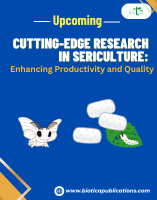 |
2025-02-15 06:40:17 |
Edit |
Delete |
| 14 |
|
|
Online Book |
Progress and Prospects in Cereal Crops Research |
Raihana Habib Kanth, Monika Ray, Joy Kumar Dey, Prajjal Dey, Ardhendu Chakraborty |
1250 |
978-81-980121-7-3 |
About the Book
It offers a comprehensive examination of recent advancements and future directions in cereal crop science, emphasizing climate resilience, genomics, precision farming, RNA interference (RNAi), policy frameworks, soil and nutrient health, and biotic and abiotic stress management. The book highlights the integration of next generation sequencing and genome editing technologies, such as CRISPR, to accelerate breeding programs and develop stress-tolerant varieties. It explores precision farming techniques to optimize inputs and enhance productivity, as well as RNAi applications for pest and disease resistance. Additionally, the book addresses sustainable soil and nutrient management practices and the importance of supportive policy frameworks in promoting agricultural innovation. By bridging scientific research with practical applications, this volume serves as a vital resource for advancing cereal crop production and ensuring global food security.
|
|
|
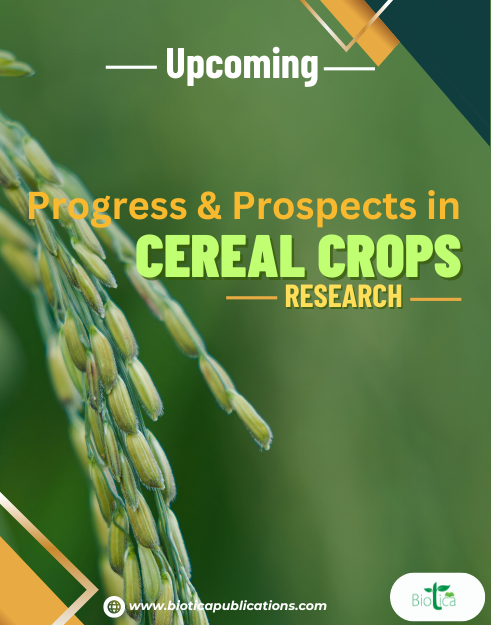 |
2025-02-15 06:41:21 |
Edit |
Delete |
| 15 |
|
|
Online Book |
Aquaculture Reimagined: Modern Approaches to Sustainable Fish Farming |
Editors: V.P. Saini, Tapas Paul, Ashutosh Kumar Singh, Abhilipsa Biswal and Rupam Samanta |
1250 |
978-81-980121-3-5 |
Cover Page: Download
Content Page: Download
ISBN: 978-81-980121-3-5
DOI: https://doi.org/10.54083/978-81-980121-3-5
About the Book:
The book is a comprehensive exploration of contemporary strategies and innovations aimed at revolutionizing the aquaculture industry with a focus on environmental and economic sustainability. This book delves into cutting-edge practices such as alternative protein sources, including black soldier fly larvae, and waste conversion technologies for sustainable feed management. It covers the use of prebiotics, Aloe vera, and plant extracts to enhance fish health and growth, alongside regional insights into diverse aquaculture practices. The text also investigates microbial-based systems, the application of ferulic acid, and the substitution of fish oil with palm oil. Addressing critical aspects of water quality management, climate-smart practices, and the economic and environmental impacts of integrated multi-trophic aquaculture (IMTA), the book highlights genetic improvements, biotechnology, and community-based approaches to sustainable practices. Through detailed case studies and real-world applications, it provides valuable insights into the successful implementation of innovative techniques. The objective of this book is to bridge the gap between traditional aquaculture and modern sustainable approaches, equipping researchers, practitioners and policymakers with the knowledge and tools needed to enhance fish farming operations. For scholars, it serves as an essential reference, offering in-depth analysis, comprehensive coverage of recent advancements, and practical applications that support the development of innovative solutions for the future of the aquaculture industry.
Published 2025
Copyright © 2025 Reserved with the Editor(s) under exclusive license to BIOTICA
Published by: Biotica Publications (India)
Printed by: Biotica Publications
How to Cite the Book?
Saini, V.P., Paul, T., Singh, A.K., Biswal, A., Samanta, R., 2025. Aquaculture Reimagined: Modern Approaches to Sustainable Fish Farming. Biotica Publications, India. p. 299. DOI: https://doi.org/10.54083/978-81-980121-3-5.
|
Chief Editor
Dr. V.P. Saini
Dean
College of Fisheries, Kishanganj, Bihar Animal Sciences University, Bihar (855 115), India
email: [email protected]
Associate Editor
Mr. Tapas Paul
Assistant Professor
Department of Aquatic Environment Management,
College of Fisheries, Kishanganj,
Bihar Animal Sciences University, Bihar (855 115), India
Mr. Ashutosh Kumar Singh
Assistant Professor
Department of Aquatic Environment Management,
College of Fisheries, Kishanganj,
Bihar Animal Sciences University, Bihar (855 115), India
Ms. Abhilipsa Biswal
Subject Matter Specialist (Animal Science-Fisheries)
Krishi Vigyan Kendra, Lada,
Dr. Rajendra Prasad Central Agricultural University, Pusa, Samastipur, Bihar (848 125), India
Dr. Rupam Samanta
Assistant Professor
Department of Fisheries Resource Management,
College of Fisheries, Kishanganj,
Bihar Animal Sciences University, Bihar (855 115), India
|
|
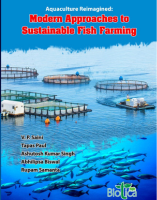 |
2025-09-25 03:02:12 |
Edit |
Delete |
| 16 |
|
|
Online Book |
Integrated Pest Management: Advancement, Adoption and Ecological Challenges |
Editor: Mukesh Sehgal |
1550 |
978-81-986377-3-4 |
Cover Page: Download
Content Page: Download
ISBN: 978-81-986377-3-4
DOI: https://doi.org/10.54083/978-81-986377-3-4
About the Book:
This book offers a comprehensive assessment of the strategies utilized in ecologically-based pest management, delivering a well-rounded examination of methods that prioritize environmental safety and ecological integrity. It delves into various subjects, including the employment of biological control mechanisms involving fungi and viruses, the preservation of natural predator populations, the application of botanical solutions and the correlation between efficient pest management and the advancement of food security. Positioned within the broader realms of agriculture, sustainability and environmental preservation, this publication presents a diverse and globally-informed viewpoint on integrated pest management. Its insights are valuable not only to researchers specializing in entomology, crop protection, environmental sciences and pest management, but also to those with multidisciplinary interests.
Published 2025
Copyright © 2025 Reserved with the Editor(s) under exclusive license to BIOTICA
Published by: Biotica Publications (India)
Printed by: Biotica Publications
How to Cite the Book?
Sehgal, M., 2025. Integrated Pest Management: Advancement, Adoption and Ecological Challenges. Biotica Publications, India. p. 215. DOI: https://doi.org/10.54083/978-81-986377-3-4.
|
Chief Editor
Dr. Mukesh Sehgal
Principle Scientist
ICAR-National Centre for Integrated Pest Management (NCIPM),
LBS Building, IARI, Pusa Campus, New Delhi (110 012), India
email: [email protected]
|
|
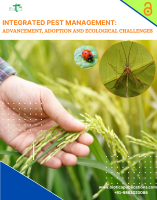 |
2025-09-25 03:10:41 |
Edit |
Delete |
| 17 |
|
|
Online Book |
Current Trends in the Diagnosis and Management of Plant Diseases |
Pranab Dutta, Gunadhya K. Upamanya, Abhay K. Pandey |
850 |
978-81-980121-1-1 |
DOI: https://doi.org/10.54083/978-81-980121-1-1
Cover & Content Page: Download
About the Book
It offers an in-depth exploration of modern plant pathology, showcasing the latest advancements and innovative strategies for disease control. The book covers molecular diagnostics, including cutting-edge tools for detecting killer pathogens and the use of DNA markers in disease management. It emphasizes eco-friendly management practices, biocontrol mechanisms of Bacillus, and the role of endophytes and microbial agents. The menace of mycotoxins in stored commodities and seed-borne pathogen detection are thoroughly discussed. Advanced topics include genomics, CRISPR gene editing, RNA interference and synthetic biology, highlighting their impact on plant immunity and resistance. The importance of phytobiomes, soil health and climate change adaptation in combating emerging diseases is examined. Readers will find insights into advanced detection techniques for fungi and bacteria, proteomics and nanotechnology applications. Integrated disease management, host plant resistance and tritrophic interactions are explored, alongside remote sensing and GIS for disease monitoring. The book also delves into biological control of post-harvest diseases, growth-promoting rhizobacteria and microbial volatile organic compounds. With its comprehensive coverage and focus on sustainable, eco-friendly practices, this book is an essential resource for researchers and students dedicated to advancing plant health and crop protection.
|
Chief Editor
Dr. Pranab Dutta
Professor
Department of Plant Pathology
College of Agriculture,
Central Agricultural University (Imphal), Kyrdemkulai
Meghalaya, INDIA
Mobile & Whatsapp: +91-9678906650, +91-9101551247
Email: [email protected]
Associate Editors
Dr. Gunadhya K Upamanya,
Associate Professor,
College of Agriculture, Dhubri,
Assam Agricultural University, Assam, INDIA
Dr. Abhay K Pandey,
Scientist,
Tea Research Association,
Nagrakata, West Bengal, INDIA
|
|
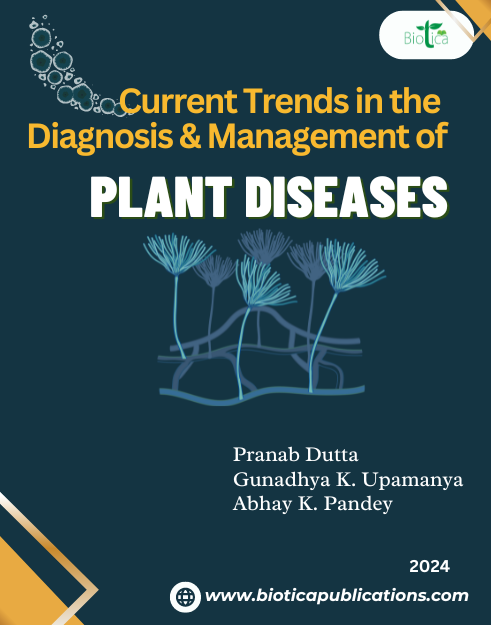 |
2025-02-06 03:03:31 |
Edit |
Delete |
| 18 |
|
|
Upcoming Book |
ID 17 Fruits & Plantation Crops Production and Management |
Open Access Book |
Coming soon |
Coming soon |
Background
The book "Fruits & Plantation Crops Production and Management" is a comprehensive resource designed for scientists, researchers, students, and farmers. It provides in-depth insights into modern production technologies, best agronomic practices, and sustainable management strategies for a wide range of fruit and plantation crops. Covering essential topics such as crop selection, soil and nutrient management, irrigation techniques, pest and disease control, and post-harvest handling, this book serves as a practical guide for maximizing productivity and quality. With a special focus on integrated pest management, organic farming approaches, and climate-resilient cultivation techniques, the book bridges the gap between scientific advancements and field applications. It incorporates case studies, research findings, and innovative practices that enhance farm profitability and sustainability. Whether for academic learning or practical implementation, this book is an invaluable reference for improving fruit and plantation crop production in diverse agro-climatic conditions.
Each chapters must have the following contents elaborately
- Introduction/Origin
- Varieties
- Soil and climate
- Season of planting
- Planting material
- Field preparation
- Planting
- Spacing
- Irrigation
- Intercropping
- Manures and fertilizers
- Interculture operation
- Plant Protection
etc.
**Authors are free to include more information
CHAPTER SUBMISSION PROCEDURE:
Book Chapter may be submitted through e-mail: [email protected]
FOR ANY QUERIES:
Contact:+91-9863023086
Mail us: [email protected]
Authors' Guidelines Publication Package
|
|
IMPORTANT DATES:
- Chapter booking ends: 25th April, 2025
- Chapter submission ends: 25th May, 2025
CHAPTER SUBMISSION PROCEDURE:
Book Chapter may be submitted through e-mail: [email protected]
FOR ANY QUERIES:
Contact:+91-9863023086
Mail us: [email protected]
Authors' Guidelines Publication Package
|
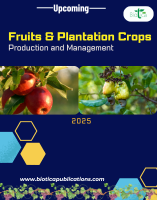 |
2025-03-29 09:03:48 |
Edit |
Delete |
| 19 |
|
|
Upcoming Book |
ID 16 Field Crops Production & Management |
Kharif & Rabi |
Coming soon |
Coming soon |
Background
This is a comprehensive resource designed for scientists, researchers, students and farmers. This book presents the latest innovations, technologies and best practices in the cultivation and management of major field crops. It covers improved production techniques, soil fertility management, precision farming, climate-resilient strategies and integrated pest and disease management. Emphasizing a holistic approach, it integrates traditional knowledge with modern scientific advancements to optimize crop yield and quality. The book also provides insights into government policies, organic farming and post-harvest management. By bridging the gap between research and practical application, this book serves as a valuable guide for academia and practitioners alike, promoting sustainable agricultural development.
Each chapters must have the following contents elaborately
- Introduction/Origin
- Varieties
- Soil and climate
- Season of planting
- Planting material
- Field preparation
- Planting
- Spacing
- Irrigation
- Intercropping
- Manures and fertilizers
- Interculture operation
- Plant Protection
etc.
**Authors are free to include more information
CHAPTER SUBMISSION PROCEDURE:
Book Chapter may be submitted through e-mail: [email protected]
FOR ANY QUERIES:
Contact:+91-9863023086
Mail us: [email protected]
Authors' Guidelines Publication Package
|
|
IMPORTANT DATES:
- Chapter booking ends: 25th April, 2025
- Chapter submission ends: 25th May, 2025
CHAPTER SUBMISSION PROCEDURE:
Book Chapter may be submitted through e-mail: [email protected]
FOR ANY QUERIES:
Contact:+91-9863023086
Mail us: [email protected]
Authors' Guidelines Publication Package
|
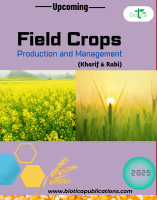 |
2025-03-29 09:14:17 |
Edit |
Delete |
| 20 |
|
|
Upcoming Book |
ID 15 Modern Poultry Science: Integrating Genetics, Nutrition and Management |
Open Access |
Coming soon |
Coming soon |
Background
The book provides a comprehensive overview of contemporary poultry production, covering key areas such as the evolution and improvement of poultry breeds, advances in genomic selection and gene editing, and the role of epigenetics. It examines nutritional requirements, innovative feed formulations, and the use of prebiotics and probiotics. The book also addresses best practices in housing, biosecurity and welfare standards, alongside strategies for disease prevention and control. Market challenges, including economic issues, global trade impacts, consumer preferences and sustainability, are critically analyzed. Current research topics like poultry immunology, climate change effects, microbiome research and reducing antibiotic use are explored. Integrative themes highlight the synergy between genetics and nutrition, genotype-environment interactions and precision farming. With case studies and practical applications, the book offers valuable insights for researchers, industry professionals and students, addressing both scientific advancements and practical challenges in poultry science.
Tentative Titles/Themes of Chapter (New chapter titles may be proposed)
Theme 1: Diversity and Evolution of Poultry Breeds
Theme 2: Heritage Breeds in Modern Poultry Production
Theme 3: Genetic Improvement of Commercial Poultry Breeds
Theme 4: Hybrid Poultry: Advantages and Challenges
Theme 5: Emerging Breeds for Sustainable Poultry Production
Theme 6: Genomic Selection in Poultry: Techniques and Applications
Theme 7: CRISPR and Gene Editing in Poultry
Theme 8: Epigenetics and Its Role in Poultry Development
Theme 9: Genetic Markers for Disease Resistance in Poultry
Theme 10: Breeding for Behavioral Traits in Poultry
Theme 11: Advances in Poultry Nutrition: From Feed to Food
Theme 12: Nutritional Requirements for Different Poultry Species
Theme 13: Feed Formulation and Optimization for Poultry
Theme 14: Role of Prebiotics and Probiotics in Poultry Nutrition
Theme 15: Nutritional Strategies to Enhance Poultry Product Quality
Theme 16: Best Practices in Poultry Housing and Environment
Theme 17: Biosecurity Measures in Poultry Farming
Theme 18: Automation and Precision Farming in Poultry Management
Theme 19: Welfare Standards and Ethical Considerations in Poultry Management
Theme 20: Optimizing Reproductive Performance in Poultry
Theme 21: Common Poultry Diseases: Prevention and Control
Theme 22: Avian Influenza: Threats and Mitigation Strategies
Theme 23: Managing Bacterial and Viral Infections in Poultry
Theme 24: Parasitic Infestations in Poultry: Diagnosis and Treatment
Theme 25: Innovative Vaccination Strategies in Poultry Health Management
Theme 26: Economic Challenges in the Poultry Industry
Theme 27: Impact of Global Trade on Poultry Markets
Theme 28: Consumer Preferences and Trends in Poultry Products
Theme 29: Regulatory and Policy Issues Affecting Poultry Production
Theme 30: Sustainability and Environmental Impact of Poultry Farming
Theme 31: Emerging Research in Poultry Immunology
Theme 32: Novel Feed Ingredients and Their Impact on Poultry Health
Theme 33: Climate Change and Its Effects on Poultry Production
Theme 34: Microbiome Research in Poultry: Implications and Applications
Theme 35: Innovative Approaches to Reduce Antibiotic Use in Poultry
Theme 36: Integrating Genetics and Nutrition for Enhanced Poultry Productivity
Theme 37: Genotype-Environment Interactions in Poultry Production
Theme 38: Advances in Precision Breeding and Nutritional Management
Theme 39: Sustainable Poultry Production: Integrating Genetic and Nutritional Innovations
Theme 40: Multidisciplinary Approaches to Addressing Poultry Health Challenges
Theme 41: The Future of Poultry Breeding: Trends and Predictions
Theme 42: Innovative Feed Technologies for the Next Generation of Poultry
Theme 43: Digital and Smart Farming Technologies in Poultry Management
Theme 44: Harnessing Big Data and AI in Poultry Research
Theme 45: Future Challenges and Opportunities in Poultry Science
Theme 46: Case Studies in Genetic Improvement of Poultry Breeds
Theme 47: Real-world Applications of Advanced Nutrition Strategies in Poultry
Theme 48: Successful Management Practices from Leading Poultry Farms
Theme 49: Overcoming Disease Outbreaks: Lessons from the Field
Theme 50: Market Innovations and Success Stories in the Poultry Industry
**Note: Chapter title may be modified or new chapter may also be proposed by the author.
CHAPTER SUBMISSION PROCEDURE:
Book Chapter may be submitted through e-mail: [email protected]
FOR ANY QUERIES:
Contact:+91-9863023086
Mail us: [email protected]
Authors' Guidelines Publication Package
|
|
IMPORTANT DATES:
- Chapter booking ends: 25th April, 2025
- Chapter submission ends: 25th May, 2025
CHAPTER SUBMISSION PROCEDURE:
Book Chapter may be submitted through e-mail: [email protected]
FOR ANY QUERIES:
Contact:+91-9863023086
Mail us: [email protected]
Authors' Guidelines Publication Package
|
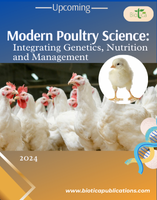 |
2025-03-26 11:42:48 |
Edit |
Delete |
